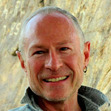Max Carmichael's Blog, page 31
May 17, 2017
The People Who Adapted
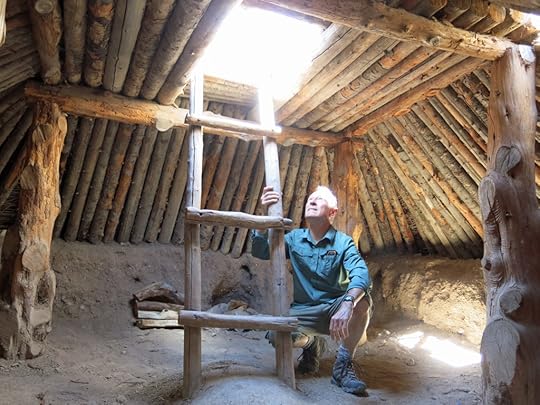
Art on the Rimrock
From the Mojave Desert, I traveled northeast to the Colorado Plateau, where I camped among pinyon and juniper near the rim of a sandstone canyon. My campsite faced the setting sun across a broad, shallow basin blanketed with sagebrush.
In the morning, I drove farther into the back country, passing prairie dog colonies with their popup lookouts, and followed a trail down from the top of a mesa to a rimrock escarpment. Hundreds of feet below, a creek opaque with grey-green sediment raged, carrying water down from snow on distant peaks.
Near the end of the escarpment, ancient people had made pictures in the sandstone. These pictures are attributed to farmers from a thousand or more years ago who lived in earth houses, whose remains are found all across Utah, often under modern towns and cities.
Village in the Canyon
During completion of an interstate highway, a boy who lived in a canyon in its path told his father about ruins he’d seen on a hill that was being attacked by bulldozers. Eventually, the bulldozers were temporarily halted and a team of archaeologists surveyed and excavated the hill, finding the largest known village site of the mysterious farmers who are believed to have created much of the prehistoric rock art in Utah.
After the village site and its house ruins were excavated and artifacts removed, construction of the interstate highway resumed, almost completely destroying the hill and its ancient village. In partial compensation, the state opened a museum to store and display artifacts and educate the public about the vanished community.
The Canyon
The Art
Anglo settlers have always known this canyon to be rich in rock art.
The People
Apart from the rock art attributed to them, the ancient farmers are known for their earth houses, which archaeologists misleadingly call “pit houses.” This term reflects the Anglo-European bias in favor of technologically advanced societies that attempt to “rise above” nature and dominate the earth. Anglo archaeologists considered the ancient farmers more “primitive” than their Anasazi neighbors who built cliff dwellings far above the ground; in comparison, these primitive farmers seemed to be living underground in pits like animals.
But as I noted last fall in Closing the Circles, these “pit houses” were actually mostly above-ground, and both spacious and comfortable. Unlike the “pueblos” of the Anasazi and modern Indians of the Southwest, these earth houses were not defensive, indicating that their populations had achieved a peaceful existence. The boxy, densely populated “pueblos” with their dark, cramped rooms would more accurately be termed “fortified apartment blocks,” built and inhabited by a society that was out-of-balance, and fearful, like ours.
But most importantly, the earth houses of the ancient farmers were supremely adapted to their environment. These people did not try to engineer their habitat on an industrial scale like the Anasazi – or like our own society.
Of course, the best evidence of this society’s success would be seen not in their houses and other artifacts, but in themselves, their gardens, and the health of the natural ecosystems they inhabited, all of which seem to be lost to us now. But maybe not completely lost – modern tribes may be directly descended from the ancient villagers, and recent excavations in other parts of this area are showing that some of the ancient farmers’ fields and irrigation networks were used continuously into historic times, when they were appropriated by early Anglo settlers.
As the museum exhibit asks, “What can these ancient people teach us?” Unlike us, they put the well-being of the community above that of the individual. They lived in harmony with nature. And instead of trying to control nature, they adapted their way of life to changing conditions in a challenging environment.
As a result, they thrived for a thousand years in this place, sustaining a larger population than we do there, even with our advanced technology and vast wealth. But, also unlike us, they sustained their traditions of hunting and gathering, so that when conditions changed dramatically, instead of fighting nature, they could temporarily set aside their village farming way of life and became nomadic foragers and hunters.
The Girl
For me, the centerpiece of the museum was the multi-media story of a farmer girl who had died at the age of seventeen. From her damaged skeleton, forensic scientists had reconstructed the girl’s appearance and her likely life history, archaeologists had added cultural and societal context, a sculptor had created a life-size likeness of the girl, and a girl from a nearby modern tribe had voiced her long-forgotten story.
I’ve taken the liberty of creating this abridged version of the girl’s story, omitting some technical details and modern perspectives that can be found in the full museum version:
The Modern Nation
Anglo homesteaders came in advance of the modern nation, but within a century the nation had caught up. Its bulldozers razed the hill of the village, and its freeway paved the floodplain where the villages kept their farms, so that now the valley and its once-bustling community is merely a passing glimpse from the closed windows of the racing metal boxes rushing urban Americans from city to distant city.
I was told in the museum that Native Americans in the surrounding areas were outraged, and a native elder placed a curse on the Department of Transportation, leading to a series of mishaps and tragedies, and pleas from the government that the curse be removed. And later, laws were passed to prevent this sort of cultural destruction. But laws can be overturned, and arrogant, domineering nations seldom last as long as this community of People Who Adapted.
Homeward Bound
On my way home, I stopped in one of my favorite mountain ranges, at the far eastern edge of the territory of my favorite Indians, the heirs of the ancient farmers. I pushed my little truck dangerously through a raging stream to a clearing under tall green cottonwoods, below a cliff of layered sandstone.
When I got out of the truck, I discovered the ground was covered with shelled pine nuts. The modern Indians had used this very spot to process their harvest, a harvest they’ve sustained for thousands of years!
Crossing the last range of mountains toward home, I drove through a sleet storm at 8,500′:
May 13, 2017
The Original Organic Abstraction
In my earliest childhood, I was surrounded by the organic abstraction of midcentury textile patterns:
When I started experimenting with Sumi ink on paper in 2011, organic abstraction flowed spontaneously from my brush:
Then, a few days ago, I visited perhaps the most interesting rock art in the Mojave desert, in a lush canyon oasis on the sacred mountain of the Colorado River tribes, where their creator god began his journey down the river. During my visit, I encountered the kitsch of white peoples’ religion, I picked up their abandoned plastic trash, and I convinced an Anglo family to stop desecrating the site with their loud pop music.
May 11, 2017
Return to the Lost World
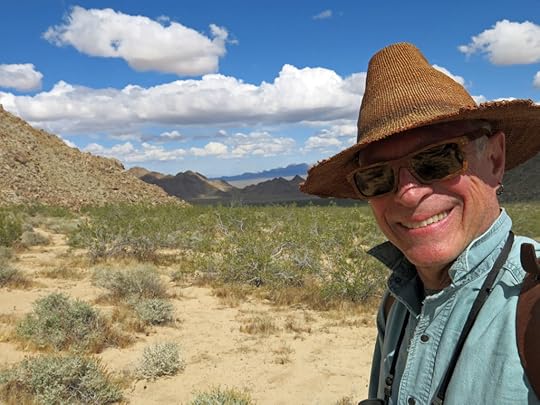
First Glimpses, and the Dream
I first saw the Lost World in April 1994, from high on the central ridge of the mountain range:
In a large and complex range, with many interior basins, this is the largest: a valley eight miles long and four miles wide. And since the passage of the Desert Bill in October of that year, it can only be legally accessed on foot.
But the barriers in the way of entering this remote valley are even greater. The Lost World is almost completely surrounded by eighteen miles of high, steep ridges and peaks. Its mouth is little more than a mile wide.
That opening at the south end of the valley is two miles from the nearest legal road, a poorly-maintained track through deep sand. From the road, it’s a two-mile hike uphill across low desert through sparse creosote scrub. There are other points where a legal road approaches within two-to-four miles of the valley, but most of those approaches involve a strenuous climb over the intervening, steep, tall ridges that almost completely encircle the valley.
I returned for another view in October 1994, and again in December 1998. I was clearly becoming obsessed with that vast, unexplored, difficult to reach valley:
Many years passed, in which I dreamed of somehow getting back in there. I remembered that in 1992, a friend who studies the wild mountain sheep had taken me in a helicopter over the north end of this valley, and across a deep canyon on the east side where I could see lush vegetation. He’d also given me a map of water sources that he’d made in a very wet year, and the map showed that even in a good year, the Lost World is devoid of water sources except in two places, both near the mouth of that canyon we’d flown over. So unless I visited after several years of heavy rainfall, I’d need to carry my own water for miles into the valley. And the warmer the weather, the more water I’d need to carry.
2015: The Northeast
The barriers to access, and the lack of water, stood in my way for over twenty years. It wasn’t until 2015 that I first set off to enter the Lost World, hiking up a smaller exterior basin on the east and over a high, steep ridge, to end up near the mouth of canyon we’d flown over. Unfortunately, the desert was still in a deep drought, and I had ended up hiking into a heat wave, so the springs were dry and I only had enough water to get back out. So I was only able to explore about two miles of the main valley floor. However, beyond my wildest expectations, I discovered potsherds, worked stone, and petroglyphs – prehistoric rock art of the Old Ones – showing that people had spent time over here, in wet years when there was reliable water nearby, probably near those very boulders.
In 2016, I did an eight-mile round-trip hike from my land in the north, up to a ridge that overlooks a northwestern corner of the Lost World. There, I had a limited view of the valley’s eastern wall, including part of the area I visited the previous year. I wanted to go back, but there was a wall in my way.
The routes I took in and out of the valley in 2015 were extremely rugged, prompting me to take a closer look at the alternatives. One was two miles to the south, but looked even more rugged on approach. Another was far to the west, and would involve a long hike around and over a narrow pass that opened into the lower, southwestern edge of the valley. Again, I would have to carry all my water. And this spring, I finally found myself in the desert again with a forecast of cool weather and rain, the best conditions I could hope for.
2017: The Southwest
I had a three hour drive to get near the pass, including about forty miles on paved highway, interrupted by several miles of detour on dirt roads, and ending on thirty miles of poorly-maintained or unmaintained, and heavily eroded, gravel, sand, and bedrock tracks. On the way, before I got to the really bad parts, I had to stop and deflate my tires for traction in sand. So I didn’t arrive in the mountains until early afternoon. Once I’d located a campsite, I did a two-mile hike to the mouth of Mesquite Canyon where I knew there’d be afternoon shade at the foot of a short cliff. There, I encountered abundant cottontails, jackrabbits, quail, and mourning doves, and anything red I carried was an endless curiosity for hummingbirds.
By the time I returned to camp, heavy, dark clouds had formed over the northern part of the range. I gathered branches for firewood and grilled all the meat I had left from last week’s shopping. Just as I finished laying out my bedding, it began to rain.
I quickly gathered my things up and retreated into the now-crowded cabin of my truck, where I watched and listened to heavy rain on the metal roof and lightning and thunder eight to ten miles to the north. It rained intermittently hard for about forty-five minutes. Then I unpacked all my bedding and laid it back on the wet sand. It was so windy, I had to turn my sleeping bag around, but after that, I finally got a good night’s sleep.
I woke early the next morning, and was able to load my pack and start hiking toward the pass by 9 am. The weather was perfect for conserving water – it would be in the 60s all day. I figured I would aim to be back by 6, for a total of nine hours of hiking. Over open ground, I could theoretically make eighteen miles in that time, but I knew I’d be stopping a lot for photos and side trips. And “open ground” is misleading in desert scrub, where every dozen yards you need to detour around a sprawling creosote, catclaw, or cactus, around an even larger granite boulder or outcrop, or down into and up out of a deep wash with steep banks of loose sand.
After the first mile of gentle uphill slope, I entered the pass itself, two miles of traversing across the foot of a steep ridge, with views of distant mountain ranges to the south between smaller, isolated peaks that form the southern walls of the pass. This pass is a really beautiful and interesting area in itself, but I was on a mission and didn’t linger much.
Finally I came out into the southwest side of the Lost World, and rounded an outlying shoulder of ridge to get my first view to the north and the extent of the big valley. Both sides of the valley are scalloped by cross-ridges and tributary canyons, many of them sizable basins in themselves, but I intended to march north past as many of these as I could, to see how far up the main valley I could get in the time I had.
Of course, the most thrilling aspect of visiting a place like this is the fact that you’ll be the only human in a huge area, perhaps the only human visitor in decades, and you will see no buildings or vehicles or ruins or any other sign of human life other than the prehistoric petroglyphs and tiny artifacts I found in 2015. I hoped to find more rock art, so I did stop and explore any prominent outcrops or boulder piles along my way that exhibited desert varnish, the black bacterial weathering that provided a canvas for the Old Ones.
In the end, I found no rock art – not surprising, since according to my biologist friend there are no springs on the western side of the valley – but I did penetrate to the northern half of the valley, where I had a view of the entire northern ridge line, including all the points where I’d looked down into the valley since 1994.
What a glorious day! I found no shade on my route, but the weather was cool enough that I didn’t need any for a change. There were so many birds out, everywhere, following me, curious about what I was doing, making noise if they thought I was threatening a nesting area. By the time I had rounded that last shoulder of ridge and taken my pictures to the north, it was time to quickly grab a snack and immediately head back. My left foot and right hip were hurting pretty bad, so I downed a couple of painkillers as well. As glorious as the day was, and as beautiful as the valley and pass were, it was a fairly painful trek back. I figured my round-trip hike to have been about thirteen miles, the longest hike I’d done in seven or eight years, since my hip condition began to deteriorate, and I had surgery.
By the time I returned to my campsite, the sun was going down, and I was exhausted, sore, and thirsty. But as I approached the back of my pickup truck, I heard a loud buzzing, and discovered that hundreds of bees were swarming the bed of my truck. I suddenly realized they’d been attracted to water that had pooled in the pickup bed from last night’s rain, since the truck was parked downhill on a slight incline. All my stuff was locked in that truck. What was I going to do?
I knew they could be Africanized “killer” bees, which have been known in this mountain range for decades. But I was desperate. I thought if I could get into the truck somehow, I could drive up the wash so that the water would drain out, and maybe the bees would lose interest. I skirted the edge of the swarm to see if bees were moving around the doors. They were, but they seemed to come and go on the passenger side, so that I might be just able to race over, unlock the door, jump in, and slam it closed without any bees following me. I didn’t give myself time to think, I just set down my pack, took the field glasses from around my neck and set them on the sand, and pulled the camera out of my hip pocket and also set it down on the sand. My folding chair was leaning against the pickup bed, so I grabbed it and moved it away, careful to move slowly so I wouldn’t anger the bees. Then I watched the bees moving past the passenger door, and made my move when I saw a short break in their traffic.
I made it, and got the door closed without letting any bees in! But before leaving that morning, I’d packed the truck willy-nilly with all my unrolled bedding and everything else I didn’t want to leave outside, so now I had to pack everything into the narrow space behind the seats, and awkwardly maneuver over the brake and shift lever into the driver’s seat. Finally, I drove a hundred feet away, up the main wash, left the truck, and cautiously walked back over to the campsite to get a drink of water from my pack.
But now, a second group of bees had separated from the main group and were swarming all over my pack, my camera, and my field glasses! My heart sank. I was so tired, so thirsty, so sore. How was this going to end?
I walked away up the wash, a hundred feet from the swarm, and sat down on a rock ledge. But soon, a bee followed and found me, so I moved another hundred yards out into the desert. I was alone in the middle of nowhere without water, food, or shelter, all of which the bees now controlled.
And even way out there, another bee tracked me and started harrassing me, so I had to get up and keep moving. I made a great circle out into the desert, thinking I’d come up on the truck from the opposite direction and see if they were still swarming the bed. On the way, I remembered that beekeepers use smoke to control hives, and I remembered I had a lighter in my pocket. I knew that dead yucca blades generate a lot of smoke, and although there were few yucca in this basin, I’d seen one up the wash, so I detoured over there, pulled off some dead blades, and scrounged some dead grass for tinder. Soon I had a smoking torch.
By the time I returned to the truck, there were only a few, sad-looking bees crawling along the bed. The sun had dropped behind the western ridge and it was noticeably cooler. When I walked over to camp, I saw only a few bees, so I started a fire in last night’s fire ring. The wind was blowing north, so smoke from the fire would keep any remaining bees away from my pack. And soon, the remaining bees were gone, and I was able to get a drink of water out of the pack, and to drive my truck back over.
I figured that with the area in shadow, it had probably gotten too cool for the bees, and they’d headed back to their hive, which was probably up Mesquite Canyon, or even over the high ridge in the next drainage. I could probably have just kept walking circles out in the desert and waited for them to leave. But the experience had really spooked me, and turned me off camping in this area. So I packed up and drove outside the mountains onto the vast western alluvial fan, where I camped that night at lower elevation on desert pavement, among very sparse scrub, with a sunset view of bright sand dunes and distant, dark ranges.
In the morning, there were just a few bees left crawling feebly around the bed of my truck. I planned to spend the day and night in town resting my foot and hip and restocking for my next attempt to reach the Lost World via an eastern approach.
2017: The East
I had so much business in town, I didn’t get back to the mountains until mid-afternoon the next day. On the way down the long dirt road past the eastern side of the range, I saw trucks blocking the way ahead, and came upon a young woman urging a tortoise across the road. She turned out to be a recent biology grad consulting for the gas company, doing tortoise training for their pipeline maintenance personnel, big guys who hovered awkwardly in the background.
I encountered two more tortoises on that road – probably a record – because the tortoises know when rain is coming, and emerge from their burrows to drink. Eventually I reached my destination and scouted a place to leave the truck opposite the canyon I was hoping to use as a route to the Lost World. Then I loaded my pack and headed up this basin I’d never explored, toward a spring I’d long heard about but never visited.
It turned out to be a mostly overgrazed bajada of soft sand undermined with animal burrows, a slow and uncertain walk uphill, but it was a cool day and rain clouds were gathering all across the desert. I was carrying a rain shell and a plastic tarp to throw over my pack, and as always was actually hoping for rain. I’d started at 2 and wanted to be back by 6 to look for a campsite, so I could theoretically cover as much as eight miles round-trip.
At the head of this basin is a giant formation of granite that looks like the Dark Tower of Barad-Dur in the Lord of the Rings, abode of the Evil Lord Sauron, so I came to think of this area as the Canyons of Mordor.
The ungrazed lower part of this basin was rich in biological soil crusts, and as I got farther in, I came upon some of the biggest silver cholla I’d ever seen. Then I encountered more birds, who teamed up and challenged me in groups, flying straight up and flapping their wings at me, showing off their dramatic black-and-white banding.
Finally I reached the head of the basin and dropped down into the main wash, which curves out of sight below the towering ridge line, which is dauntingly stony. I’d seen lots of old cowpies out in the basin, and now I came upon some abandoned plastic piping, indicating that ranchers had fed the spring water down for their cattle at some point.
Then I came around a bend of the wash, saw a big boulder covered with desert varnish, and realized some of the patterns on the rock had been made by the Old Ones. I was surprised, since friends who knew of my interest had visited this spring and hadn’t said anything about the art.
I continued up the wash, and found lots more abandoned piping, and thickets of invasive tamarisk I had to fight my way through. The canyon became steep, narrow, and winding, and there were many pouroffs and blockages of house-sized boulders that had rolled down from above, in addition to thickets of catclaw and tamarisk. The surrounding slopes, of dark, ancient granite, are topped by many strange pinnacles that our imagination can easily make into recognizable forms. But it’s a world of stone, even more so than other parts of the range.
This is supposed to be an important spring, but the higher I climbed, the more I despaired of finding water. And the ridge above wasn’t getting any closer, it was just getting steeper and more forbidding. This would not be a good route into the Lost World. Then clouds began pouring over the peaks, and I knew it was time to turn back. A few drops of rain were beginning to fall and I was getting cold.
By the time I got back to the truck, it was raining lightly. I was anxious to get to my favorite campsite – in fact the only campsite – on this side of the mountains, but it was a long stressful drive at low speed over deeply eroded dirt and rocks and uphill through deep sand. It began to rain harder, and when I finally reached the site, someone else had claimed it with a big truck and loads of gear. I wasted some more time looking in vain for another site, then I gave up, turned around and drove back down to the main gravel road out of the mountains.
I headed north, through increasing darkness and intermittent heavy and light rain. Night was falling and the storm was spreading, and the road had high banks with no place to pull out. I reached a high area of desert pavement beside a smaller mountain range and was finally able to pull off under a transmission tower. Someone had camped here and left their fire circle, but it was under a damn powerline and transmission tower, and after seriously considering it, I realized I wasn’t set up to cook dinner or lay out my bedding in the rain, a situation I’d never had to provide for in the past. This was a new experience and nothing to really complain about – being driven out of the desert by rain!
I still had to stop somewhere and re-inflate my tires. I did that in the dark, in heavy rain, beside the road. It takes a half hour. I reached town, and a motel, by 9 pm, under continuing heavy rain in the desert.
Perspectives
What’s next? Well, it would be cool to explore all those side basins and canyons. But that would take multiple days, and too much water to carry. If only we’d get several wet years in a row, to recharge the fracture zones in the granite and get the springs going again. Then maybe there’d be water on the east side, and I could actually live in the Lost World for a few days. It can’t hurt to dream!
April 30, 2017
Rendezvous With Deep Time
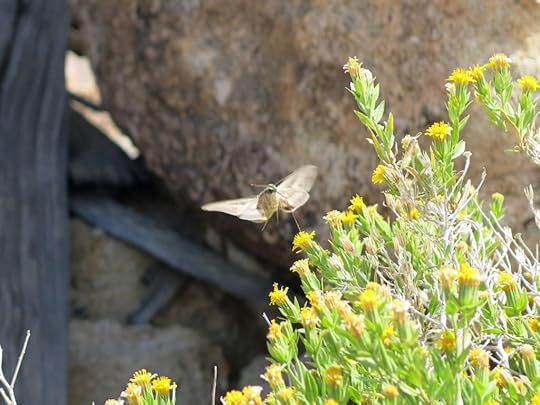
Arrival at Night, and the First Day
I got a late start, and entered the mountains just as full dark was falling and all the stars were coming out on this moonless night. The military refueling flights were occasionally deafening as they droned though their long mechanical circles overhead, but they stopped at 10 pm. Snug in my sleeping bag, there under the glittering arch of heaven, I felt much more comfortable and at home than in my bed back in Silver City.
On the first day, temperatures were mild, with alternating wind and calm, clouds and blue sky, and I hiked up to the Shade House. There, I strung my hammock and lay reading and watching birds and pollinators move among the nearby shrubs and boulders. The clouds, some tantalizingly dark, brought temporary humidity but no precious rain. I was plagued by gnats, but at least they didn’t bite. I hiked up to the seep and found the catch basin dry – something that only happens in the deepest droughts.
A Walk Across the Bajada
The next morning I woke to a cold wind and put on layers of fleece before making breakfast and coffee. Discouraged by the drought, I thought of leaving and going elsewhere. But the sky cleared and I saw the big boulder pile 2 or 3 miles across the basin, where I knew there were inner chambers with shade from the full sun of afternoon and views out across the bajada.
The walk across the bajada reminded me that this is a special place for plants. I found dense stands of healthy bunchgrass, and surprising groupings of very different plants living together in harmony, in a desert that’s more commonly known for plants that isolate themselves from each other with chemical repellents. Many were blooming, long after the “official” annual bloom, from the tiny annuals at ground level to the tall cholla cactus and creosote shrubs. And I came upon bees, butterflies, birds, rabbits and hares, all enjoying springtime on the bajada.
That night it was so windy I had to anchor even heavy things down and turn my sleeping bag away from it, to the south. I could tell the wind was on the rise and planned to leave in the morning, discouraged by both wind and drought.
Rendezvous With Deep Time
High winds in the morning. I took my time packing up, and on the way out down the broad main wash, noticed a wedge of snow on Mount San Gorgonio, a hundred miles away through a haze of wind-raised mineral dust.
Then, just outside the mountains, I unexpectedly came upon a vehicle driven by someone I only knew as a legend – the geologist who’d discovered this place and helped put it on the international map of earth science. He was bringing some young students out, hoping they’d like it enough to resume research out here. So I turned around and joined them, and the legend gave me some glimpses of an incredibly dynamic, and incredibly ancient, story.
Here, the crust of the earth, then consisting of sedimentary – the limestones, shales, and sandstones of the Grand Canyon – and ancient metamorphic rocks such as gneiss – had been folded under unimaginable forces, and interpenetrated by younger granite rising from below, and the interfaces between the rocks were incredibly complex. In fact, much of the story remains a mystery today after decades of study.
In this migmatitic exposure, beautiful marbles had been formed, and embedded with colorful skarns in reds and greens. Layer upon layer of granites and recrystallized carbonates that had flowed over and under each other repeatedly, to be eroded across eons and exposed here for us in frozen waves and thin sheets like iced cream. Almost two billion years of the Earth’s history we hiked over, up a few hundred feet of steep mountainside.
The students hungrily scanned the rocks at their feet, but the legend kept redirecting their attention up to the deep blue of the sky behind the stony ridge, and to the special plants scattered around them, like the red Dudleya and the barrel cactus, that thrive on this particular substrate. And I pointed out my new obsession, biological soil crusts, which arise at the interface between rock and life. Easily missed knots of nondescript black matter in fissures of white stone. Subdued now in the drought, but ready to swell and glisten after a rain.
January 31, 2017
How the Middle Class Destroys the World
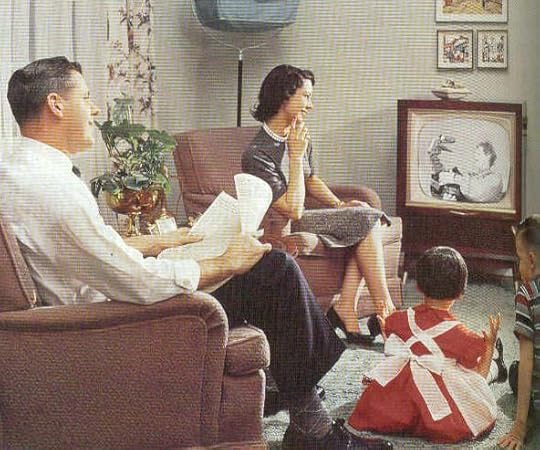 The Accountability Problem
The Accountability ProblemYou depend on many resources, products, and services to survive and stay healthy and happy: clean air and water, nutritious food, clothing, shelter, heating, cooling, communication, transportation, healthcare, and security. Do you know where all these things ultimately come from?
If not, how do you know whether someone or someplace is being harmed to provide for your basic needs?
The urbanized middle class – the bourgeoisie of Marxist theory – is considered the foundation of stable, peaceful society in the modern nation-state, and it’s what the lower classes aspire to. I was raised to join the middle class, and all my peers are raising their kids to be middle class – who wouldn’t?
But whereas the foundation of traditional societies is the local workers who provide basic needs, the modern middle class consists of consumers who depend on a global network of products and services that is so complex it is virtually untraceable and unknowable – and hence unaccountable.
In fact, you don’t know whether someone or someplace is being harmed to make your lifestyle possible.



How the Middle Class Destroys Society
Intimidation, Punishment, and Slavery
The security of the middle class depends on a nuclear arsenal capable of rendering the planet uninhabitable, a global military empire intimidating and sometimes practicing covert warfare against foreign civilians, a largely covert arms industry dominated by U.S.-based multinational corporations, and a domestic security apparatus resulting in mass incarceration of citizens, who are largely hidden away from public access in high-security prisons.
Military bases, defending the economic empire of American consumers, are imposed on the populations of much less powerful, economically disadvantaged societies, resulting in intimidation, economic dependency, and resentment.
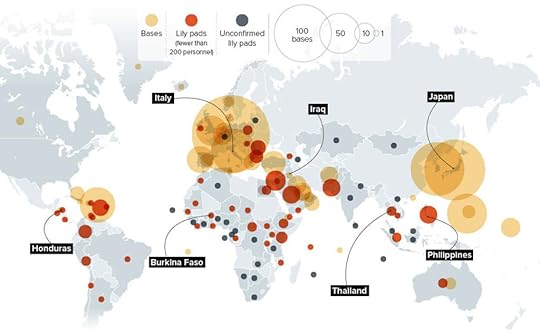
Defending the middle class: Pakistani children killed by U.S. drone strike:
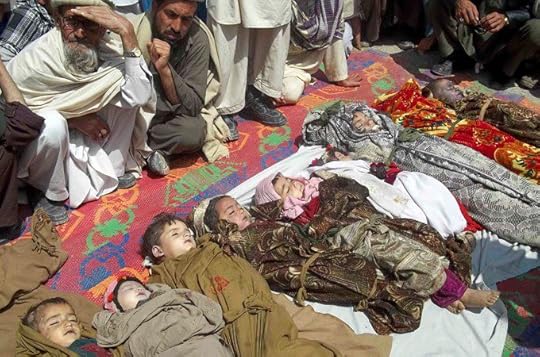
The U.S.-dominated global arms industry profits from violent conflict and human suffering:
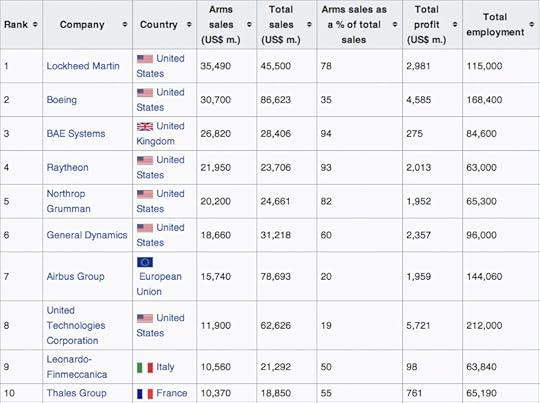
U.S.-made weapons commandeered by ISIS:

Throughout history, traditional communities practiced restorative justice, which helps the victim and heals society. But middle class consumers depend on the punitive justice system of the modern nation-state, which harms society without helping the victims. The punitive justice system and its prison network reinforce ethnic and racial inequality, perpetuate domestic slavery, and foster social dysfunction.
Growth of the U.S. prison system during the past 40 years:
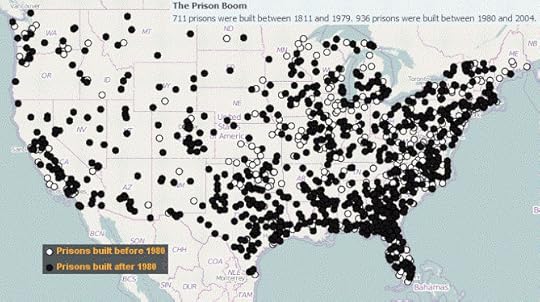
Work crew at Angola Prison, Louisiana:
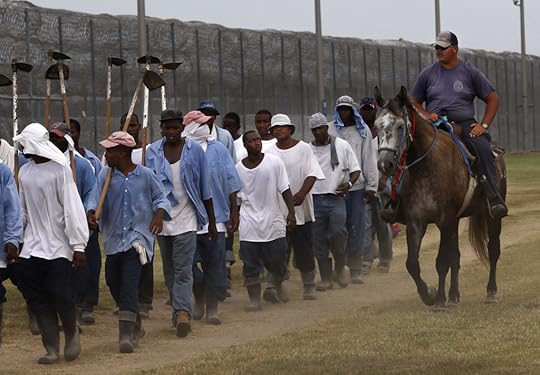
Economic Imperialism
The middle class consumer lifestyle is sustained by mass-produced products and services made affordable by large corporations and long-distance distribution networks exploiting economic inequality. Products are manufactured, and services are directly provided, by blue-collar laborers whose labor is generally valued far less than that of middle-class consumers, and who live in poor neighborhoods with a lower quality of life. Middle class waste products are transported to, and imposed on, poor neighborhoods for processing and disposal.
Since major products like food, fuel, clothing, phones, computers, appliances, cars, and building materials are typically manufactured in poorer foreign countries from components and raw materials which in turn come from other, even poorer foreign countries, workers sometimes live and work in virtual – or even actual – slavery. And the supply chain for consumer products is virtually untraceable.
MarketExample of U.S.-Based MultinationalAnnual SalesCEOAnnual Compensation
FoodMonsanto15 BillionHugh Grant11 Million
ClothingNike32 BillionMark Parker48 Million
FuelExxon Mobil269 BillionRex Tillerson (outgoing to become Secretary of State)33 Million
ShelterPulte Group6 BillionRichard Dugas8 Million
TransportationGeneral Motors156 BillionMary Barra29 Million
CommunicationsApple53 BillionTim Cook10 Million
Raw materials for consumer products needed by the middle class come from distant rural communities all over the planet, where workers and their families endure dangerous conditions, toxic environments, war, or slavery:
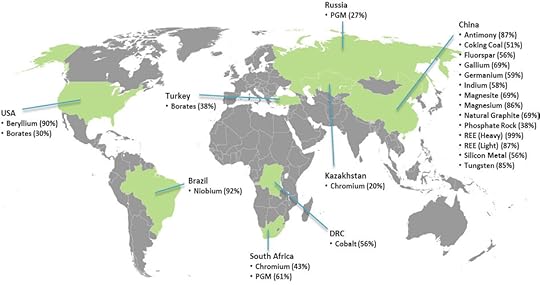
Mining for the electronics industry in the Congo:

The urban middle class depends on services – housekeeping, childcare, food service, transportation, repair and maintenance, waste disposal, etc. – provided by lower-class workers living in poor, often gang-dominated, neighborhoods.
Gang members in East Los Angeles:
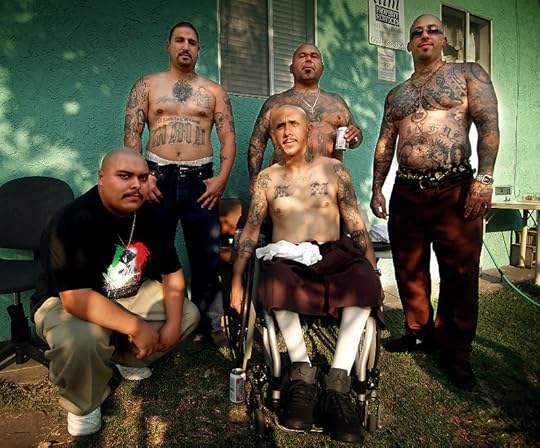
Social Division, Fragmentation, and Isolation
A college education, one of the defining requirements of the middle class lifestyle, is intended to lead to a professional career, freeing the consumer from manual labor.
Thus the primary function of “higher education” is to train young people to become office workers – people who work indoors at a computer, an inherently unhealthy artificial environment – and to condition them for a consumer lifestyle which is dependent on a disadvantaged lower class of manual laborers and service providers and the destructive global network of manufacturing and distribution. Higher education is an integral part of the vicious cycles in which dominant societies deteriorate from generation to generation.
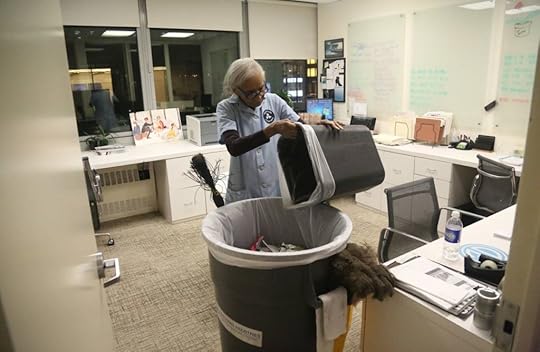
Middle class youth are generally expected to leave home for higher education, then to migrate again, possibly multiple times, in pursuit of a professional career. The move to higher education deprives them of their roots and deprives their family and home community of their social services; henceforth they are “floaters,” generally uncommitted to any local, face-to-face community. They rarely get to know their neighbors, and become temporary members of cliques of similarly isolated peers, without the intergenerational commitment and accountability that ties real communities together.

Technologically-assisted communications – email, texting, voice phone, and social media – likewise encourage the dispersion of individuals from their families and communities of origin, by allowing an impoverished form of remote interaction that takes the place of face-to-face interaction. Without the support of extended family and a tight-knit community, urban consumers fall prey to stress disorders and mental health problems such as depression, self-medicating and enriching the multinational pharmaceutical corporations. Thus are communities fragmented and disempowered, and individuals isolated and rendered vulnerable, by education, mobility, and communications media.

How the Middle Class Destroys Natural Habitats and Ecosystems
Habitat Destruction
The media have taught urban consumers that climate change is the biggest threat to our environment. But habitat destruction, which often results in species extinction, is the primary form of ecological damage resulting from the middle class consumer lifestyle. Climate change is only one long-term form of habitat destruction – other forms are much more catastrophic in the near term.
Urban Sprawl
Urban sprawl, providing housing for the middle class and the blue-collar workers they depend on, is one of the most extreme forms of habitat destruction, in which productive ecosystems are completely destroyed and replaced by machines and impermeable surfaces which concentrate wastes and toxic materials, increasing erosion and spreading the damage to the surrounding areas.

Since cities are dependent on a network of infrastructure delivering resources from the surrounding countryside and other distant trading centers, their damage extends outward globally to infrastructure and industry located out of sight and out of mind.
Industrial Wastelands
Industrial sites such as dams, mines, commodity farms, and factories, created to provide resources for consumers, also completely destroy productive natural ecosystems, replacing them with concentrations of toxic materials.
Tesla “gigafactory” destroyed a large area of wildlife habitat in the Nevada desert:

Infrastructure Barriers
The infrastructure required to deliver resources to urban areas and facilitate communication and mobility between them results in transportation and communications corridors which become toxic wastelands and barriers to wildlife.
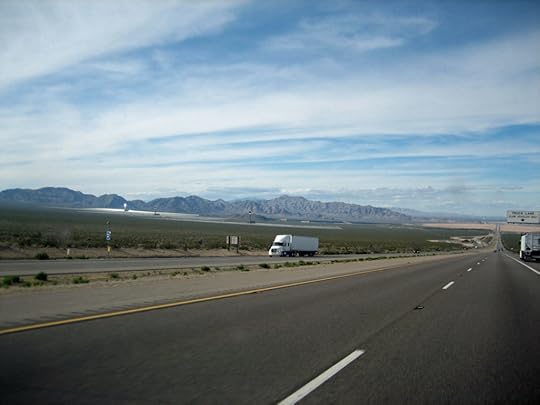
Toxic Innovation, Toxic Materials
The continual improvement of middle class comfort and convenience through technological innovation results in a short product life cycle and rapid obsolescence. When obsolete products are discarded, few are recycled, and many, such as batteries and electronics, add toxic materials to the environment. Innovation is incredibly wasteful.
…high-tech products are usually composed of low-quality materials–that is, cheap plastics and dyes–globally sourced from the lowest-cost provider, which may be halfway around the world. This means that even substances banned for use in the United States and Europe can reach this country via products and parts made elsewhere….They can be assembled into, say, your treadmill, which will then emit the “banned” substance as you exercise. (William McDonough & Michael Braungart, Cradle to Cradle)
One of the most revolutionary scientific inventions of the past century was disposable containers which were intended to be dumped in landfills after a single use. As time went by, these containers came to be made almost exclusively of plastics, which take centuries or even millenia to degrade. Since the 1950s, the use of plastics has accelerated, especially by the middle class, in the form of food packaging, shopping bags, clothing, storage containers, disposable water bottles, phones, toys, furniture, appliances, cars, etc.
As these items age and erode, often imperceptibly, into the environment, they break down into microscopic particles or “microplastics” which spread throughout aquatic and ocean environments and are ingested by wildlife, interfering with animal and plant life cycles in unpredictable ways. The microplastics catastrophe is just beginning and may eclipse other problems we are now more concerned about.

Microplastics disperse in the aquatic environment:
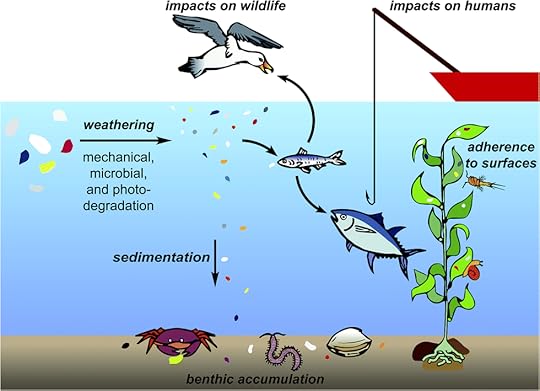
Microplastics damage aquatic life:
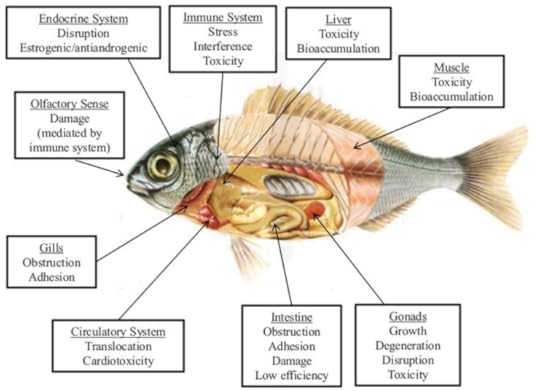
Toxic Mobility
Technological advances in human mobility – travel and distribution by land, water, sea, and air – ensure the rapid spread of disease and invasive species, accelerating ecosystem damage and habitat destruction worldwide. Most destructive species are spread accidentally, but many are introduced intentionally: rabbits in Australia as a source of meat, pythons in Florida and bullfrogs in the American West by irresponsible pet owners.
This map of global ship traffic shows how invasive species have been spread from continent to continent historically, as nations and empires have used technology to enrich themselves and subject native ecosystems to collateral damage:
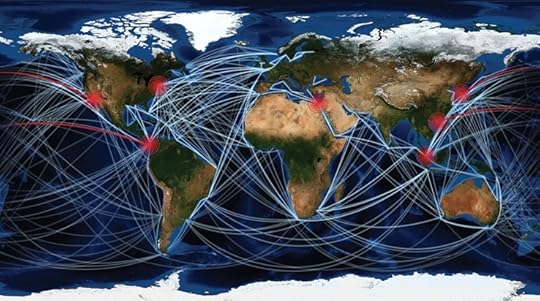
Container ships delivering products and raw materials to American consumers also bring destructive invasive species:

Scientists estimate that technologically-enhanced human mobility has historically delivered 4,300 destructive invasive species to the U.S., ranging from Burmese pythons driving native species extinct in Florida to nutria destroying native habitat in Louisiana, from feral hogs devastating ecosystems in the South to European starlings starving native birds nationwide. The economic cost of damage by invasive species in the United States is estimated at $120 billion per year and will continue to grow as a result of technological innovation increasing human mobility.
I lived in the San Francisco Bay Area for 30 years, and during that period, like most residents, I came to accept a landscape dominated by invasive plant species as “nature.” Invasive eucalyptus trees covering the hills, invasive ice plant along the coast, invasive yellow star thistle blanketing the inland meadows. It was only after I moved to southwest New Mexico, far from the coast and its ports, that I began to experience relatively intact, and far more diverse, native ecosystems.
Cheatgrass, an Old World species introduced to North America in the 19th century, has spread across most of the U.S., displacing native plants, encouraging destructive wildfires, reducing the nutrient quality of rangelands, and impoverishing native ecosystems.
Contemporary distribution of destructive Asian cheatgrass:
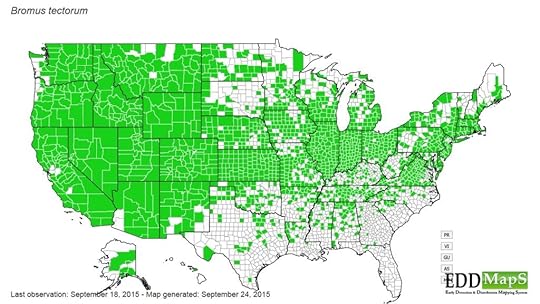
Rangeland devastated by fire after cheatgrass invasion:
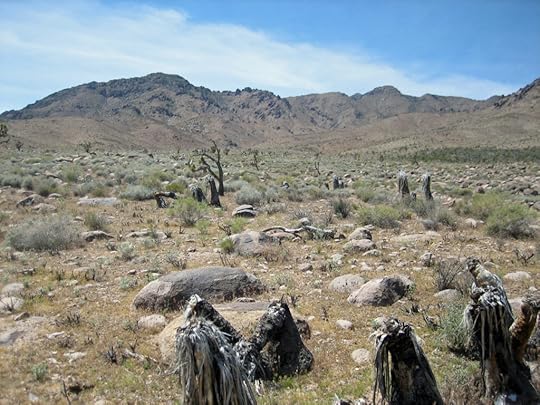
Asian zebra mussels have been spread across North America by boaters since the 1980s:
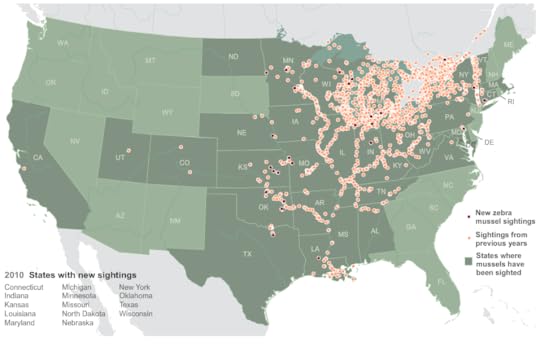
Crayfish encrusted with zebra mussels:
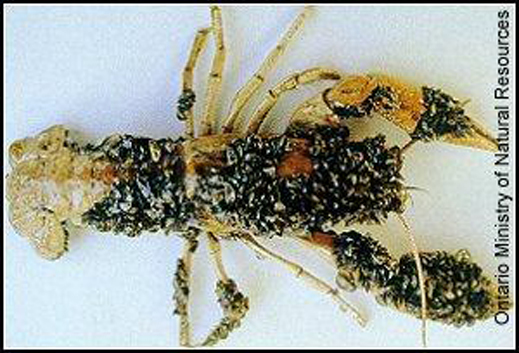
Energy Consumption
Technological innovation and consumers’ insatiable demand for gadgets ensures ever-accelerating consumption of energy, resulting in increasing destruction of natural habitat for mining, manufacturing, and the siting of energy production. Fossil fuels and nuclear energy require oil fields, mines, raw materials and manufacturing for plant components, industrial sites for energy plants, and disposal sites for toxic waste. Solar and wind energy require mines, raw materials and manufacturing for plant components, industrial sites for energy plants, and disposal sites for toxic waste.
This solar power plant in the Mojave Desert destroyed many square miles of wildlife habitat and continues to kill thousands of birds and pollinators:
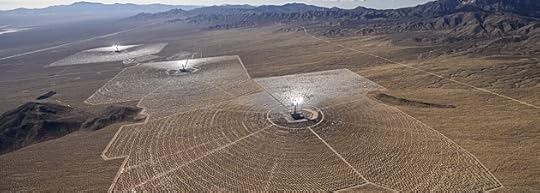
False Hopes of the Middle Class
Politics
The centralized nation-state is made possible by a hierarchy of wealth and power. It functions primarily to enrich and empower elites, and is inherently destructive. And when the fundamental institutions of society – the ecological and social values and practices – are destructive, as described above – then political reform is like rearranging the deck chairs on the Titanic. Middle-class society depends on the global economic and military empire maintained by the elites, and to give these up would be class suicide for either group. To paraphrase Karl Marx, politics is opium for the masses.
Green Energy and Electric Cars
So-called “green” energy is an industry like any other. Its function is not to save the planet, its function is to enable middle class consumers to continue consuming more and more energy with their devices – devices which rapidly become obsolescent and are discarded and replaced, devices whose operations add waste heat to the environment, devices which concentrate toxic materials in the environment, devices which harm society in many ways, some of which have been described above.
Electric cars are machines assembled from thousands of components whose global supply chain is untraceable, via a manufacturing process and distribution network which are energy-intensive and wasteful just like that used to produce conventional fossil-fueled cars. The function of electric cars is not to save the planet, it’s to perpetuate the already destructive mobility of middle class consumers while making billionaires even richer.
Recycling
As technological innovation accelerates, more waste is produced. The vast majority of our waste is not recycled, and when it is, recycling degrades the quality of the materials. It also requires more energy and labor on top of that required to manufacture the original products. So recycling increases our already destructive consumption of energy.
As we have noted, most recycling is actually downcycling; it reduces the quality of a material over time…the high-quality steel used in automobiles…is “recycled” by melting it down with other car parts, including copper from cables in the car, and the paint and plastic coatings…Downcycling can actually increase contamination of the biosphere. (William McDonough & Michael Braungart, Cradle to Cradle)
Space Colonization
Some tech billionaires, and many engineers and science fiction fans, believe that we should, and will, save the planet we’re destroying by abandoning it to colonize other worlds. This fantasy results from their ignorance of ecology and human social behavior. Who gets to emigrate? Middle class American consumers? Agribusiness billionaires? Mexican farm workers? ISIS militants? It’s our dysfunctional behavior that’s destroying the earth – transplanting that behavior to another world solves nothing.
Even if some colonization happens, it won’t be sustainable. A healthy environment for humans isn’t engineered from scratch, by “terraforming” another planet. It evolves with the participation of uncountable wild organisms in a terrestrial ecosystem, and humans adapt to it just like their nonhuman partners. This is the only planet we have, and it will survive with or without us.
There is some talk in science and popular culture about colonizing other planets, such as Mars or the moon….But the idea also provides rationalization for destruction, an expression of our hope that we’ll find a way to save ourselves if we trash our planet. To this speculation, we would respond: If you want the Mars experience, go to Chile and live in a typical copper mine. There are no animals, the landscape is hostile to humans, and it would be a tremendous challenge. Or, for a moonlike effect, go to the nickel mines of Ontario. (William McDonough & Michael Braungart, Cradle to Cradle)
To me, the human move to take responsibility for the living Earth is laughable – the rhetoric of the powerless. The planet takes care of us, not we of it. Our self-inflated moral imperative to guide a wayward Earth or heal our sick planet is evidence of our immense capacity for self-delusion. Rather, we need to protect us from ourselves. (Lyn Margulis, Symbiotic Planet)
How Local Providers Renew the World
Producers Not Consumers
Dominant, large-scale, centralized societies are destructive by nature. They have their own life cycle and exist primarily for the short-term benefit of the rich and powerful. They are not successfully managed or reformed for the benefit of local communities and ecosystems. The best we can do is minimize our dependence on them, transitioning from globally-dependent consumers to locally-accountable providers.
The best we can do for the earth and its people is to become successful producers and providers of basic needs for our local communities, conserving and re-using as much as possible of what we do consume, learning to do all this sustainably, and sharing what we learn so that future generations will succeed as well as us.
Local Heroes
Wherever we live, we can usually find people and organizations that are focusing their efforts on providing locally for local needs: farms, food co-ops, childcare centers, healthcare clinics, restorative justice services, churches, etc. These are the groups and people we should support and emulate, to rebuild our communities and thus take the load off the rest of the world.
Small-town farmer in New Mexico shows school kids how corn is re-seeded:
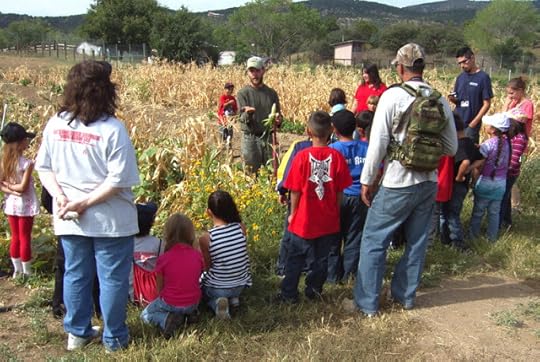
Urban youth learn to serve their community with restorative justice in Kansas City:
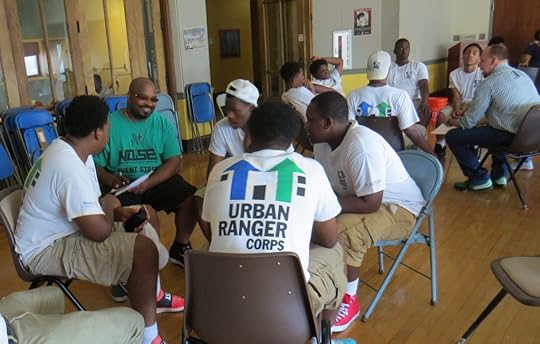
Traditional aboriginal skills are needed by the community to adapt to environmental crises, from crop failure to fire, flood, and war.
Students learn to process meat from an animal they killed on an indigenous skills course in Utah:
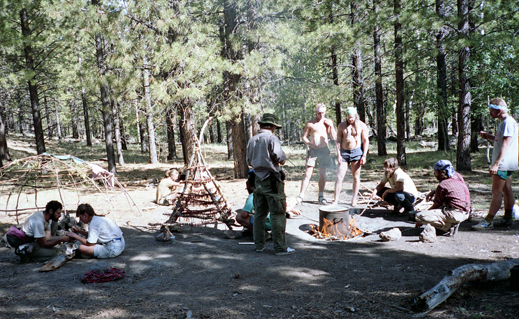
Peaceful Societies
While our dominant society destroys itself, there remain many little-known peaceful societies that offer the best hope for a sustainable future of humanity. These societies exist in the margins where they have been more or less successful at resisting the dominant society’s destructive impacts, perpetuating time-tested traditional practices and adapting to crises while our society continues to innovate and engineer itself to death. They are our best teachers.
Amish farmers in North America resist the destructive effects of technological innovation:
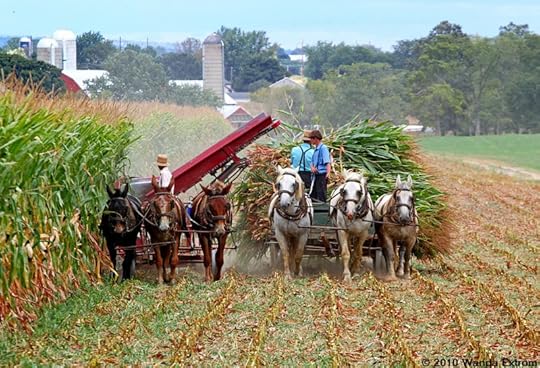
Unlike American middle-class consumers, the Piaroa of South America manage their natural resources communally and sustainably:
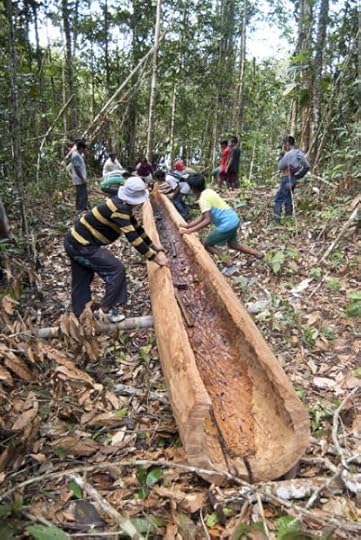
Instead of leaving their families to learn to be office workers and consumers, Ju/’hoansi children of southern Africa join their parents on foraging expeditions, learning to be providers for their community:
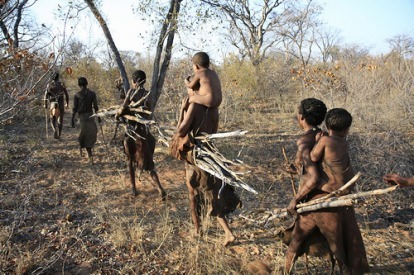
Like whales and other ecosystem partners, the Ifaluk of the South Pacific fish communally:
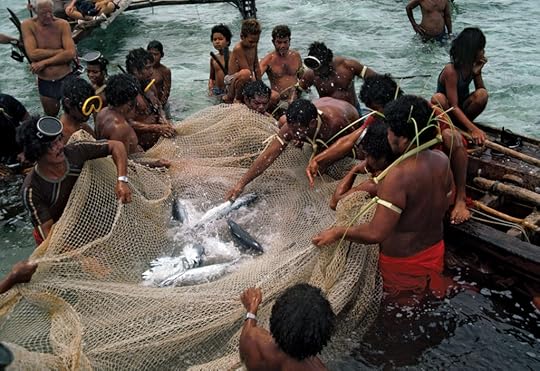
January 28, 2017
Nations Fall, Communities Rise
In childhood, our schools taught us the version of history told by the victorious conquerors: the myth of progress from savage, superstitious tribes to civilized, scientific democracies; the heroic quests of explorers, colonists and pioneers seeking freedom from oppression and a better life; the wisdom of the Founding Fathers, Lincoln freeing the slaves, modern medicine conquering disease, the democratic Allies saving the world from fascism, the environmental movement saving the planet, and science and technology making our lives safer and easier and liberating us to seek our highest potential as individuals.
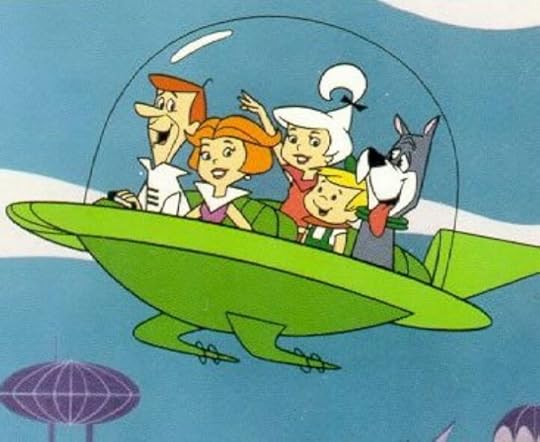
Now that we’re adults, the corporate news media – romanticized as the “free press” – demand our full, uninterrupted attention to the President and his national power structure, threatening that if we turn away, we risk apocalypse. And urban consumers, dependent on the massive support systems governed by those talking heads, believe in the threat. The media predict what consumers want to hear, and consumers rejoice. Then the media report the opposite, and the shocked and saddened consumers return to the same sources, now seeking solace, enlightenment, and guidance. Consumers come to believe they have actual, important relationships – however dysfunctional – with strangers they will never meet, who are known only as talking heads on the screen.
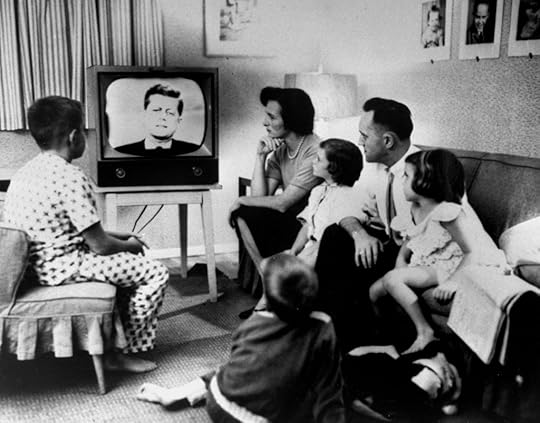
Peaceful societies like the Amish of North America, the Piaroa of South America, the Ju/’hoansi of Africa, the Rural Thai of Southeast Asia, and the Ifaluk of the South Pacific, are burdened with none of these misapprehensions. They know their existence is always subject to disruption by external powers beyond their control, but they remain self-sufficient, independent, and vigilant, and they have learned to adapt to crises peacefully, avoiding conflict and migrating away from it when necessary.
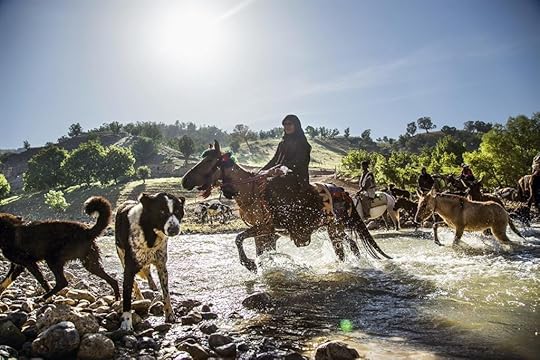
Likewise, minorities with a history of persecution know better than to depend on kings or presidents for survival or salvation. The self-sufficiency of the North American Anabaptists is the result of generations of violent persecution in Europe. Mormons encourage self-reliance and often require their children to learn indigenous survival skills. And while the Black Panthers were seen by the centralized power structure as violent revolutionaries, the majority of their work consisted of peacefully providing social, health, and subsistence services to their local communities.
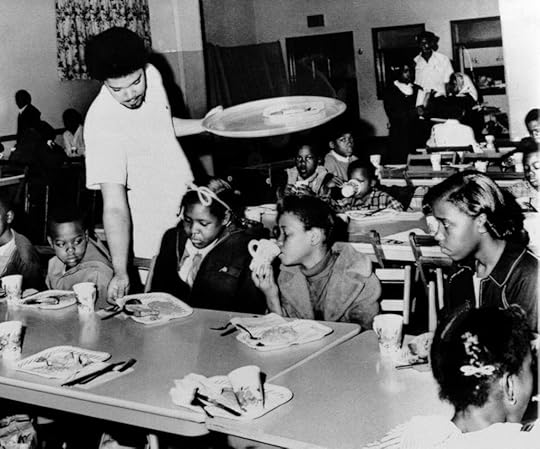
Consumers’ dependence on the centralized nation-state derives from their belief in the nation-state as a bastion of security and stability, and their fear of chaos and apocalypse should it collapse. But this is a myth perpetuated by the power structure. A reality check on history shows that the nation-state is continually destroying itself and its environment. The United States was founded in violence: the conquest of Native Americans, a revolution against the British, the establishment of borders and the defense of them. The story of its growth to a world power is the story of traumatic conversion of resilient rural subsistence communities to cities full of isolated, vulnerable consumers, and the continual, ongoing destruction of healthy natural habitat and its replacement by toxic industrial tracts and urban sprawl. Consumers remain mostly unaware of this, since they seldom leave the city and are habituated to artificial environments.

During the Third Reich and World War II, the democratic Allies allowed fascism to spread and failed to prevent the Holocaust – nor did they save the world from fascism; they increased the devastation with a world war and millions more deaths, while the Nazi regime and the Japanese empire self-destructed through hubris, militarism, and overextension. Likewise, the democratic nation-states of Western Civilization pursued a policy of imperialism leading to the Rwandan genocide, and after more than a century of “progress” and “enlightenment,” the same nation-states failed to prevent it or stop it while it was happening.
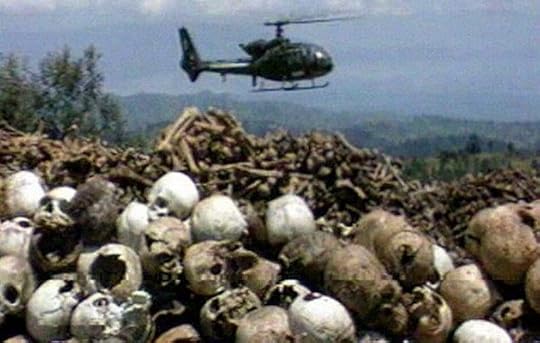
The myth of societal collapse and apocalypse stems from the misrepresentation of the European “Dark Ages,” the misnamed period after the collapse of the Roman Empire which was in reality a Golden Age of local freedom and autonomy after centuries of oppression by the imperial nation-state. Citizens of modern democratic nation-states blame the ongoing failure of Egypt, Tunisia, and Syria on religion and superstition, whereas these failed states are themselves the artificial inventions of the European democracies. The destruction, misery, and refugee crises resulting from these societal collapses demonstrate the ultimate vulnerability of urban populations and the danger of depending on centralized, hierarchical power structures.

When the citizens of Western nations begin to sense their own vulnerability and begin to fear the apocalypse, they manifest their naiveté in dysfunctional movements like libertarianism and prepping – fallacies common to even the wealthiest and most powerful citizens. These ideologies result from historical Anglo-European competitive individualism and widespread ignorance of anthropology and ecology, holistic sciences which reveal the superiority of communal societies. When centralized societies collapse, people who selfishly hoard resources and weapons to defend their families are doomed to repeat the cycles of self-destructive violence, whereas people who cooperate and peacefully nurture their local communities, adopting the lessons of the peaceful societies, are likely to thrive.
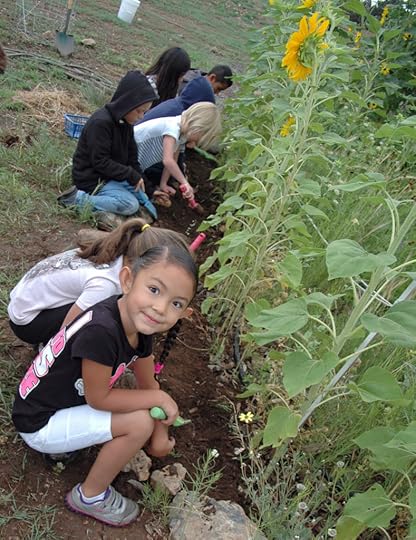
January 26, 2017
The Terra Incognita Loft: Part 5 1989-Present
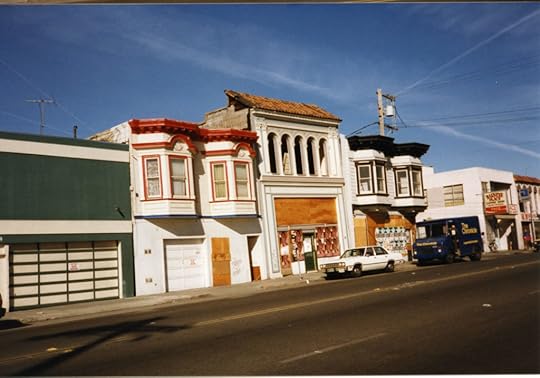
Let It Come Down
It happened just after 5pm on Tuesday, October 17. John was at work downtown, and made it outside okay; he was able to walk back to Fifth Street. Leslie was working across the Bay, as was I. The engineering company I worked for was in the Berkeley Marina, on landfill. The wood-frame walls and doorways of our second floor office seemed to turn to rubber. I braced myself in a doorway as the drunken thrashing of the world around me went on for a long moment, file cabinets and bookcases tumbling across the rooms. From the moment it started, I knew my home and studio was gone, down, collapsed. It could never withstand the Big One.
I shut down my thoughts and feelings and went into full survival mode. After the shaking stopped, and we’d determined that the building was still standing and everyone was okay, I invited my co-worker, Mae, to hit the road with me. She also lived in the city and was worried sick about her partner over there. There were no cell phones or internet in those days. Regular telephone service was down. Power was out. Nothing but static on the radio.
I drove the new Tracker up the marina road toward Berkeley, where a mushroom cloud now rose thousands of feet into the sky. Ahead of us, the road had split in half, with one side of the pavement a foot lower than the other. Before time stopped, it had been rush hour, and the freeway was packed, with traffic at a standstill. Skipping the on-ramp, I took the frontage road beside the Bay toward Emeryville. It took a long time, and when we got there, the freeway ramp to San Francisco was blocked. I decided to try to get to Mike the drummer’s house in Oakland. The streets near the freeway were also jammed, so I drove my new high-clearance vehicle over the railroad tracks into back alleys behind factories, and finally made it to Mike’s place as darkness fell. His lights were on, but he told us the Bay Bridge was down and San Francisco was burning.
We watched Mike’s TV in silence as they showed the same helicopter footage over and over, of a blacked-out city lit only by raging fires in my South of Market neighborhood and in the Marina District to the north. Hours later, I was finally able to reach John at the loft by phone, and Mae connected with her partner. They were both fine, and John said the loft was damaged but, miraculously, still standing. The toilet had been shattered by falling masonry, and the power was off, but the phone was back on. My heavy stereo amplifier had been thrown off the top shelf onto the floor, but most of our stuff was still upright, including the heavy old refrigerator and the gas water heater, which we’d secured with metal straps after the earlier quake.
The Bay Bridge was indeed closed – a section of the upper roadway had collapsed – but Mae and I both needed to get home, so I took the long way around, via the Richmond Bridge, Marin County, and the Golden Gate. I dropped Mae off at her place in Noe Valley, then headed for South of Market. It was about 2am when I rolled down darkened Folsom Street, driving slow and swerving to avoid trash can fires and homeless people staggering like zombies through the rubble. I gave the darkened loft a quick check, said hi to John, grabbed some clothes and overnight stuff, and returned to stay with Mae and Xenia in their intact apartment up on the bedrock of a hill, where the electricity had come back on.
Ann, property manager for our landlord Chuck, stopped by the loft the next day, and Chuck immediately dispatched a plumber to replace the toilet. It seemed like a crazy reaction in the larger context, but crazy things were happening all over as some people wavered in denial and others frantically tried to restore business as usual. The entire Bay Area was in shock, and much of San Francisco was paralyzed. Blocks of homes had collapsed or burned, people had died in a collapse in our own neighborhood, power would be out for days. Communications were so chaotic that it was days before anyone learned that a double-decker freeway in Oakland had collapsed, crushing dozens of commuters in their cars.
I got Leslie on the phone; she was staying at her old place across the Bay. We agreed to meet at the loft on Friday. In the meantime, I called Ann and told her to get the building inspected. We couldn’t go on living there without knowing whether it was safe.
Transportation systems were down – people couldn’t get to their jobs – crews of orange-vested officials were seen everywhere, red-tagging buildings – but somehow Ann found us an engineer. I accompanied them into the bowels of the building where the main structural columns were exposed. They all had longitudinal cracks, and the rusted and broken ends of the rebar stuck out like spaghetti. The engineer didn’t really have to inspect anything, he just took a quick look and said this building was done for, totally unsafe, it would have to come down. I knew it had been unsafe long before the earthquake, before we’d even moved in. A disaster waiting to happen.
Love Among the Ruins
Leslie and I returned on Friday, and spent our last nights in the loft. A storm was coming in off the Pacific, and on Friday night I dreamed I was carried up into the eye of the storm. Saturday night I dreamed I was carried down under the earth through a tunnel. I was carried smoothly forward, past arching rock walls that glowed brighter and brighter, until I reached the epicenter of the quake, where I was overwhelmed by light and warmth and a sense of relief and peace.
On Sunday, Katie came over to help me pack. She invited Leslie and me to stay in her studio. She unfolded her sofabed, made it up with sheets and a comforter, and tucked us in. Leslie and I spent much of the night telling each other the story of our lives, but that was all that happened.
I hired a moving crew and rented a storage space in the East Bay, taking all the major appliances, believing I’d find another live-work space soon. But property owners and managers had doubled or tripled the rents on vacant spaces, taking advantage of all the displacement. And nothing was anywhere near as nice as our loft.
After the loft was red-tagged, the utilities were permanently shut off, but John and Quinn decided to camp there as long as they possibly could, thriving in danger. By contrast, Carson and Kay had recently bought a house way up on the north coast, in the pastoral, anachronistic village of Ferndale, and they invited Leslie and me up for a break from our hopeless search for housing. There, walking on the beach one afternoon, I tried to kiss her, but she turned away, saying she wasn’t ready.
FEMA finally set up a local operation to aid earthquake victims. Leslie and I waited in line in Oakland for hotel and meal vouchers. They were only valid at the cheapest chains. The only motel we could find, way up in Richmond, had stained carpets that smelled like piss, and a bed that visibly sagged in the middle. But we got our takeout voucher dinners, I bought a six pack, and we propped the window open to ease the odor in our room. Leslie asked me for a massage, and we finally found release from all the trauma and desperation in each other.
Over Thanksgiving holiday, she talked the manager of her old Mills College dorm into letting her stay there. The outside doors were locked, so I had to toss pebbles against her second-floor window at night so she could come down and let me in.
The desert property question was still floating out there, and my friend Michael from Los Angeles, another desert lover, was interested in joining me in it. In December, while I was still homeless, we drove out together to look at the two candidate properties, on opposite sides of the mountain range. He fell in love with the old man’s place at first sight, noting it would be like owning our own national park. And his mother was willing to give us a loan. So we asked the old man in Vegas if he knew anyone who could close the deal for him.
Meanwhile, the city had finally gotten around to red-tagging the loft. John and Quinn, who had been camping romantically in the ruins, there in the midst of the crippled and traumatized city, finally moved out, and Dancy boarded up the facade and put a big padlock on the street doors.
The Terra Incognita band played a couple of final gigs, one on New Year’s Eve in a Mission District loft where both Katie and Leslie were dancing in the audience, and another at a private affair in a park. Leslie and I remained homeless, but together, for months, while Michael and I were closing the deal on our desert property. Sometimes Katie let us sleep in her studio. Eventually, although she mockingly referred to her as “Teenage Barbie,” Katie got young Leslie a job as receptionist at Colossal Pictures. I moved into the three-bedroom apartment Katie shared with her friend Ken in the building above her art studio, and Leslie found a room in a house in the Mission.
Into the New World
In the late 1980s, Reagan, our criminal President, had talked our “enemy,” the Soviet Union, into embracing the rudiments of capitalism. Then in early 1989, Chinese students massed in Tiananmen Square in Beijing, demanding more freedom, but the Communist government brutally suppressed them, massacring thousands. George Bush, another conservative from a family of Nazi collaborators, had won the presidential election in 1988, and in November 1989, a few weeks after our earthquake, the Berlin Wall was opened between East and West, and its demolition begun. Naive Western Europeans and Americans celebrated, having been taught to see these events as the inevitable triumph of good over evil and proof of the moral superiority of capitalism over communism and socialism.
One afternoon in the new year of 1990, months after the quake, I found myself in our old South of Market neighborhood, and swung by the loft, which was still standing and still boarded up. I noticed two men outside Olen’s shop and pulled over. It was Olen and his son. Olen had had a stroke and couldn’t speak, but he recognized me and smiled. The son explained that they were trying to retrieve a car from inside our building.
The lower floor of the loft had a dogleg garage extension onto Shipley alley. We managed to raise the rollup door, but Olen’s old VW Beetle, which didn’t run, was down inside, in the dark, at the bottom of a ramp. Together, the three of us labored and slowly pushed it up and out onto the street. Olen beamed. Back in the day, he’d been the King of Fifth Street. Now, only a few months later, he was a ravaged old man, barely functioning, collateral damage of the earthquake. It was the last time I saw him, and the last time I saw the loft standing. Chuck’s three condemned buildings disappeared as if they’d never existed, to be replaced by a sunken dirt parking lot, which remains to this day.
Leslie and I drifted apart. We stayed friends, but she moved back to Chicago, where she’d grown up. I attended a two-week primitive skills class in the wilderness of Utah where I learned the lifeways of the Indians who lived in my beloved desert and left the rock art Katie and I had studied, and in 1991, four years after the last Pow-Wow, I organized another Pow-Wow at Philippe and Cindy’s field station, this time starring the lead instructor from my Utah class, and adding new friends to the old crowd from both Northern and Southern California.
John and Quinn got married and spent a long honeymoon in Spain and Italy. Back in the Bay Area, they started a family and later moved to Ireland, where John joined a theater group and Quinn did archaeology. Recently, they returned to the Bay Area.
Two years after the quake, I moved into a small house in Oakland with a carport where I could store the appliances from the loft, so I retrieved them and all my other stuff from storage. Part of me was still hoping to get another industrial space that I could build out, to create another dream studio and home.
In the Oakland house, I reassembled my recording studio and reviewed my decade-long musical career. The last iteration of the Terra Incognita band had been the most musically coherent and successful, but in some ways the most frustrating. The lead guitarist’s work, and the long solos by him and the other players, had constantly grated on my traditional-music sensibilities, and we’d never found a backing vocalist that suited me, but all the players had been so accommodating and supportive of me and my songs that I’d never had the heart to challenge or replace them. Instead, in another of my typical creative flip-flops, I abandoned the big band sound and went acoustic, resurrecting my banjo, ordering and learning to play my own custom-made West African drums, writing more desert-inspired songs, and adopting a deep-tribal sound explicitly inspired by archaic Nigerian and Appalachian styles.
But my passion for the desert was quickly taking over. We’d finally acquired our land and were starting to do habitat restoration work. I decided to just move out there and live on the land – working with desert scientists, delving deep into the ecology and archaeology, testing my new aboriginal skills in the middle of the wilderness – so I finally sold off all the old loft appliances. It was a hard time and place for selling – even the Wedgewood range went cheap. I quit my day job at the Berkeley engineering firm, for the last time, and it went out of business within a few years.
Loft of Dreams
In September 1993, four years after the quake, I was back in the Bay Area, and we relived the golden years of the loft in a Terra Incognita reunion. Laurie flew out from Minneapolis, and Katie, Laurie, John, Quinn, and I took the ferry to Angel Island where we picnicked and made music together at The Bell.
After the reunion, Katie moved back to Los Angeles, and I visited her there. In Minneapolis, Laurie and Marc had divorced. He’d pursued a career in poetry, and later took his own life, but Laurie had gone on to become an acclaimed creator of public art in the Twin Cities, tackling difficult issues like domestic violence and suicide.
I moved into the Oakland house of Mike the drummer from the TI band, and we started a new group, Wickiup, with Jane, a Cherokee singer and multi-instrumentalist, to try out my idea of a deep-tribal sound that we called Acid Country or Native American Country Gospel. Hotel Utah, a legendary bar and nightclub in the old loft neighborhood of San Francisco, was now managed by Guy, the lead bass player from the short-lived 1988 version of Terra Incognita. There, Wickiup debuted “Precious Time,” the song about Leslie, the loft, and the quake that I’d written while we were still homeless in early 1990. We performed and attracted a loyal audience for two years before I got tired of that style and flip-flopped again, inspired by the now-popular grunge movement from Seattle.
I moved to Los Angeles in 1995, and Leslie flew out from Chicago two years in a row to join me in camping trips to the desert. I started making desert-inspired pastels again, and experimented with Asian-inspired ink brush art. And gradually, after years of unemployment and poverty, I reinvented myself as an information architect in the Dotcom Boom, and moved back to the Bay Area for a high-pressure new career as a “creative professional.”
When I founded the loft in 1981, my young peers and I had been part of a generation that was angry and skeptical, disillusioned with government, politics, industry, media, capitalism and consumerism. Our opposition to the established system and mainstream culture was the source of our hope for the future and the inspiration for our creativity. But now I was working with creative young people who were making tons of money working for corporate clients. They fervently believed that technology and capitalism would bring about Heaven on Earth: a democratic, globally networked playground filled with sparkling, kaleidoscopic screens, friendly robots and rocket cars. I would ride the wave, but I had seen too much to share that dream.
In 1997, eight years after the quake, I started dreaming about the Terra Incognita loft. It’s as if it continued to exist in a parallel universe – actually, any number of parallel universes, because the city around it continues to change, modernizing in different ways each time, and the loft itself is different in every dream. Sometimes it’s the same space, and sometimes it’s bigger, with extensions, or just with more monumental dimensions. Most of the time, strangers are living there and transforming it in cool and intriguing ways. But sometimes, it’s the same, and some of the old roommates have returned. I still have these dreams and I expect I always will.
I also reconnected with Tiare in 1997 – by phone, mail, and email – but we have yet to meet face to face. She’s happily married and living in the Los Angeles area, and still making art. And much later, after moving to New Mexico, I reconnected with Gary, Mark, and Scott from the original Terra Incognita band. Mark continues to experiment with his fiddle, Scott’s a successful actor, and Gary paints, having taught art to seniors until his retirement this month.
I opened the San Francisco office of my design business in North Beach in 1999, and one day while grabbing a sandwich at Molinari’s deli across the street, I glimpsed someone who looked like Popeye, the dashing but mentally ill older man who’d lived in the flophouse around the corner from the loft, parading around the neighborhood in flamboyant costumes. Like Popeye, the man I saw in North Beach looked clean cut and physically fit. He wore a white shirt and dress slacks, and carried grocery bags. When I described him to my young assistant, she said he was a widely-known, independently wealthy San Francisco personality that she and her husband had spoken with several times.
The ultimate triumph of the loft was Jon and Laurie’s marriage. Jon had landed a prestigious editing job in Minneapolis in the mid-1990s, and since Laurie was already established there, they started hanging out together, and I was eventually privileged to serve at the wedding of these two friends who had first met at Terra Incognita 16 years earlier. And Jon has resumed the career in performance art that he and I first dabbled in at the loft in 1981.
I love and miss all my talented and courageous friends from the nine years of the Terra Incognita loft. As artists, we needed a place that was ours to experiment with, outside the constraints of society. A place that was illegal and dangerous, forcing us to stay alert and learn how to keep from falling off the sharp edge of art, love, sanity, even life itself, that we so often balanced precariously on. Terra Incognita was that place, and it served us better than anyone could ever have dreamed, and in our dreams and memories it will never die.
January 21, 2017
The Terra Incognita Loft: Part 4 1987-1989
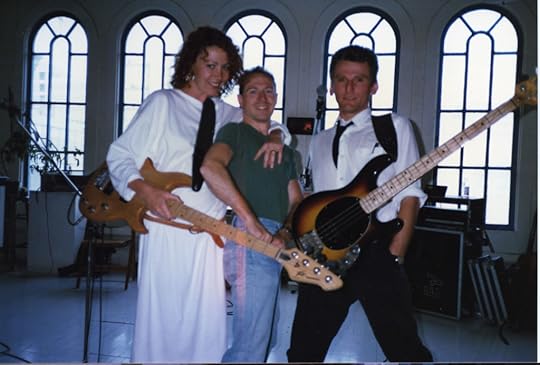
Pow-Wow ’87
With Laurie’s departure at the end of summer 1987, the loft population was back to three. I’d been without an art studio for almost three years, and Katie’s projects had been wedged into a corner of the guest room, so we took over Laurie’s room, and on the nights we didn’t have rehearsal or a gig, we had art nights.
My pastels were now all about the desert: forms I’d seen or dreamed, stylized like Native American rock art. Back in 1986, after hearing from Chris, the biology student, that the University of California had established an ecological field station near our desert cave, we’d driven over there and met the new directors, Philippe and Cindy. The four of us clicked from the start and became good friends. They began to turn us on to the ecology and prehistory of our favorite place, the ongoing research and the people who were conducting it. Our heads were exploding with this new universe of images and ideas for our art and music. The more we learned, the more we wanted to know.
Our loft technology was also advancing. Back in 1985, we’d acquired a massive, used IBM Selectric electronic typewriter to produce lyric sheets, songbooks, and promotional correspondence for the band. But after the Pow-Wow in 1986, we’d replaced it with an Apple Macintosh computer and dot matrix printer. John had already set up a workstation in the hallway with his MS-DOS computer, so we added the Mac and began experimenting with graphics for posters and databases for our band mailing list.
John’s latest project was a brilliant Spiderman web of rope he strung across his room below the ceiling, from his sleeping loft to the opposite wall, so he could roll out of bed into it and crawl around up there. We knew he was airborne from the creaking sound of the ropes.
In the fall, despite our sadness over the loss of our roommate, the momentum of our activities kept intensifying. I’d been corresponding with Jon about the next art/science Pow-Wow, and with Philippe and Cindy about holding it on their desert field station, at the ranch house where we’d met Chris in December 1985. Katie had initially been skeptical about our Pow-Wows, thinking they’d be too nerdy and uncool, but now she was fully on board, along with our large community of artist friends in Los Angeles, for whom the desert was only a short drive away.
Philippe and Cindy put Pow-Wow ’87 on their calendar for late October, and I prepared a two-page invitation on our Mac and sent it out to dozens of people on our mailing list. As both artists and scientists eagerly signed up, I compiled text and images from dozens of references Katie and I had acquired during our desert researches and produced a 200-page Reader on this environment most attendees would be experiencing for the first time, and its prehistoric culture. As I had with previous projects, I printed and bound the Reader surreptitiously at my day job, after hours, and mailed copies to all the Pow-Wow registrants on my own dime. Many of them would read it out loud during their journeys to the desert, preparing questions and special projects to share with others.
Meanwhile, Katie was tirelessly badgering record companies with our recent recordings, and our friends Norman and Benjamin had scored us a gig headlining a Friday night show at the Knitting Factory in New York City, based on the Village Voice review of our track on the Potatoes album. This was our biggest opportunity ever – the Knitting Factory was the leading showcase for new and experimental music in the U.S.
The first desert Pow-Wow was a massive group effort. Jon flew from New York to Las Vegas, where he met John and Ellen from the Bay Area and they all rented a car to drive to the remote field station. Michael and others from Los Angeles carpooled and hauled loads of firewood, food, and beverages. Katie and I drove down from San Francisco on Wednesday and stayed at our cave the first night, to be joined by other Bay Area friends at the ranch house on Friday afternoon. Gear was unloaded and a cooking assembly line was set up in the kitchen, supervised by Katie and our friend Tia, a professional chef and caterer, while people erected tents amid the cactus and scrub outside.
As before, the first night was devoted to introductions, but this time in a circle outside around a roaring campfire. The desert had endured a drought for years, but after we went to bed, the drought was miraculously broken by a gentle, steady rain that lasted all night.
On Saturday we split into smaller groups for team activities and field trips: the game of Granite Ball invented by our friend Mark N from Los Angeles, the volunteer installation of solar panels near field station headquarters, an expedition among the boulders to investigate prehistoric rock art. Around the fire that night, we all learned more about the place, its history, and its issues from Cindy and Philippe.
The latest Pow-Wow had such a profound effect on people that they spent weeks processing what they’d learned, and sent us art, poetry, and essays in response during the coming months.
Terra Incognita in New York
The Terra Incognita band‘s big national hit, “Rank Stranger,” employed two electric basses, so we recruited loftmate John into the band to play the second bass in our shows beginning that fall. In addition to the Friday night Knitting Factory gig, Norman and Benjamin got us a Wednesday night date at the popular King Tut’s Wah Wah Hut in the Village, and a Thursday afternoon improv performance with Benjamin at PS 122, a trendy art venue.
On Tuesday evening, the four of us packed up our instruments and amps and boarded a flight out of SFO. It was Mark’s first flight, and almost his last. A blizzard lay over New York, and we were re-routed into a vast circular holding pattern to avoid it. The plane was repeatedly battered with turbulence, and at one point, a lightning bolt actually shot through the fuselage, from window to window, in front of Mark’s seat. We circled tensely for more than two hours, finally landing in Newark.
We cabbed to the Mansfield, an elderly but clean hotel in mid-Manhattan across the street from the legendary Algonquin. It was popular with musicians, and we soon found ourselves sharing lines of coke with a heavy metal band from Manchester, England. The city was blanketed by several inches of fresh snow, enough to make it truly magical but not enough to immobilize us. In between our gigs, we explored the city as a group, continuing the time-honored tradition dramatized in Beatles movies like A Hard Day’s Night, pelting each other with snowballs and amusing the locals with our juvenile hijinks and wide-eyed enthusiasm.
My mother Joan and her fiance Jack had flown out and were staying on Washington Square in the Village. They joined all of our New York friends at the packed Knitting Factory show. But we totally bombed it. I’m not sure it was as discouraging to the audience as to us, but the stress of our biggest gig ever had taken its toll. Mark, Katie, and John had partied too much with the boys from Manchester, and I, normally at home on the stage, was as nervous as if I’d never been in front of an audience before. We did two sets, alternating with Benjamin and Norman, and our second set was no better than the first. We flew back to San Francisco with our tails between our legs. Our only consolation was that our gig had been on Friday the 13th.
Speeding to Collapse
Terra Incognita’s disappointing Knitting Factory performance turned out to be a harbinger of worse things to come. Like the military in past wars, and the energy industry and other physically-demanding blue-collar livelihoods, the movie industry had come to accept the abuse of dangerous stimulants, and Katie’s workplace, Colossal Pictures, was no exception. The pressure we’d shouldered in our pursuit of a record company deal and the New York tour was coming to a head, and we resented the need to sleep, the lost hours when we could be productive. With some people drug abuse was partying; with us it was strictly a productivity issue.
In January 1988 this turned into a marathon of teeth-grinding and sleepless nights trying to write music in the wee hours of the morning, followed by zombie-like staggering around our day jobs. Of course, the drugs didn’t actually make us more creative – they made us the opposite, more nervous and uptight.
The last show of the Terra Incognita electric string band was at Noe Valley Ministry, an all-wooden church that was acclaimed for having the best acoustics in San Francisco. It had been one of the few venues in the Bay Area that we hadn’t been able to book yet; our friend Pamela Z, the pioneering electronic composer and performance artist, had finally gotten us in. Our performance was videotaped by Stuart – the only video ever shot of this band – but he refused to share it with us afterwards.
Throughout our performance, John, who stood behind Katie and I, kept drifting out of sync with us, and at one point during a song, I whipped around in frustration to see what was happening. John seemed oblivious to his surroundings. A week later, while Katie and I were away on a camping trip, he collapsed and was rushed to a hospital, where he was diagnosed with a serious, totally unexpected medical condition.
Building a New Band
After making sure John could handle his new reality – it was harsh, but John had always been a survivor – Katie and I sobered up and took stock of our troubled musical project. We felt handicapped by the band’s lack of musical skill and polish, but we had no intention of letting go the creative reins or the lead vocals. Although we’d worked on lyrics and laid down plenty of sweet instrumental tracks, neither of us had finished any new songs in years. And our recent live recordings had exposed our arrangements as tense, herky-jerky, cerebral clutter. Just as we’d reached the peak of our career, we lost faith in what we were doing. We decided to disband and recruit new, professional musicians: a bassist and lead guitarist to free up Katie and me so we could focus more on our singing, and a drummer to round out our sound and take the place of Mark’s fiddle picking.
The bassist came first. Not long after the Noe Valley Ministry fiasco, we attended a show at the Kennel Club by Snakefinger, a legendary guitarist and one of our Ralph Records labelmates. His bass player, Guy, was a virtuoso player with strong stage moves and a striking presence. I invited him over to the loft for a powwow. He was excited about joining us, but wanted creative equity – the chance to play and sing his own material, which he hadn’t been able to do with his previous bands. It was a challenge to my ego, but Katie talked me into it.
Katie and Guy got recommendations for various percussionists that we auditioned at the loft, but none of them impressed me – either too mainstream or too hippie-dippy. I put up a notice at the Art Institute and Michael responded. From the beginning of our first conversation, even without hearing him play, I knew he was perfect. He’d studied at Berklee College of Music under Ronald Shannon Jackson and had played in Kotoja, a Bay Area afro-funk band led by Nigerian star Ken Okulolo. In addition to the standard kit, he played a talking drum, the most charismatic instrument from West Africa, and was a conga master. He also had strong stage presence – he worked part-time modeling for art classes and had even done some fashion work. And like me, he was committed to music with a spiritual dimension.
The lead guitarist proved to be the hardest to find – unsurprisingly, because I’ve never really cared for lead guitarists or guitar solos. The first few auditions brought us rock players burdened with all the cliches in the book. Finally we settled on Mike, a modest, collaborative player with jazz chops who liked African music and loved our songs.
Love Will Tear Us Apart
The band wasn’t the only thing that needed fixing. Katie and I were in trouble in other ways. Despite all the passions and activities we shared, from music to the desert, our relationship had been dysfunctional from the start. Freaked out by her temper and other mismatches between us, I’d started viewing and treating her like a sister instead of a lover. I was blocked creatively, but she couldn’t write songs without me, and I refused to help her since I couldn’t help myself.
In early spring, while our musician search was still underway, we took a weekend getaway to Jenner, a romantic seaside village north of the Bay Area. The first night, we had just ordered an expensive gourmet meal in the fancy, crowded restaurant above our room when I said something wrong and Katie had a meltdown and stomped out, leaving me to eat alone amid the stares of other diners. We made up afterwards and spent the next day tripping in our room, watching and listening to a storm over the ocean, but we knew nothing had been fixed between us.
Someone recommended a couples counselor. The hour we spent there consisted of Katie accusing me, in relentless detail, of making her miserable. At the end, the counselor said she couldn’t help us and we should just break up.
This shocked both of us. I’d expected that I would get a chance to speak. We both assumed this would just be the beginning, that the counselor would offer us counseling. Neither of us was ready to give up. Leaving the office, we hugged each other tightly and cried all the way to the car.
We temporarily set our relationship problems aside to spend the summer rehearsing and recording the new band, putting together a demo to book gigs with the new sound and start all over with our promotional activities. Alongside this, Katie and I still had art nights in our shared studio, and in addition to her photography and printmaking, she had started to experiment with a new form of assemblage or sculpture using both natural and industrial detritus that she picked up during road trips.
As frustrating and traumatic as our winter had been, it had shaken something loose in me, and I started writing new songs for the first time in years – most of them inspired by the desert. Katie and Guy were also introducing new material, so that not only did we have a new band, we had a new repertoire as well.
Some well-heeled jazz lovers had bought the building down the block from us where Harvey’s store used to be, and were spending lavishly to turn it into an elegant, upscale jazz club. Our neighborhood was still dominated by artists, poor ethnic families, addicts, ex-cons, and the mentally ill, but the huge Moscone Center project, only a couple of blocks away, had progressed throughout the decade, accumulating the pressure that would ultimately gentrify South of Market. When the Milestones club opened, my dad, a lifelong jazz fan, came down from Sacramento for opening night to hear Joe Henderson, John Handy, and a young piano prodigy from New Orleans named Henry Butler. It was only a few steps from the loft, but my dad couldn’t climb our stairs due to his heart condition and obesity. It would be the last live music we saw together.
Finally the new Terra Incognita band was ready, and we booked our debut in September at the Paradise Lounge, our “home venue” and one of the anchors of the South of Market club scene, which had expanded over the years from a narrow storefront to two floors and three separate stages that could host simultaneous acts. We learned that famed producer Todd Rundgren would be checking us out, and we recruited friend and Colossal art director Stuart to videotape our show.
The show went well, but a few days later, Katie announced that she’d had an affair with Guy, the bass player, over the summer. He was married; the affair had ended and he’d gone back to his wife, but she couldn’t keep it to herself any longer, and needed some resolution between us. Of course, I was shocked, and saddened, but in a sense I was also relieved. I arranged for a meeting of the three of us, where I said that Katie would have to move out of the loft, and I wouldn’t be able to play music with either of them again.
Next I had to meet with Michael, the drummer, and Mike, the lead guitarist. I had no idea what would happen, but they both comforted me and offered their full support and total faith in my music. They said all we needed was to find another bassist and a female vocalist, and things would be better than ever.
So that’s what we did. Wendell, our suave and deep-thinking new bass virtuoso, responded to my ad and joined almost immediately. Finding a female vocalist was much harder – we worked with a series of them over the next year. But initially, it was just the four of us, and we were gigging again by December.
Late one night near the end of the year, I was working at the computer when I heard someone unlocking the street door downstairs, and heavy boots climbing the stairs. It couldn’t be John, who always wore soft-soled shoes. Suddenly Katie appeared, towering in the kitchen doorway, dressed in a long black leather coat. I hadn’t seen her since she’d moved out in September. “I’m going to kill you!” she said.
I was still seated as she strode across the kitchen and kicked our big metal trash can at me. It clattered and rolled away as I rose from my seat, and she turned and ran back toward the front of the loft.
I followed, and when I got to the top of the stairs, she was waiting on the landing below. Her eyes flashed murder and she charged up the stairs toward me. I had the advantage and it was now or never, so I jumped, we grappled, and rolled together back down to the landing. She was crying and hugging me even before we got there. Damn – we’d been together through thick and thin for more than four years – I’d hurt her deeply and didn’t know how to make it better. I missed her and wished we could’ve stayed friends.
Stuck in the Desert
As 1988 turned into 1989, I had a huge empty space in my life to fill. I was single for the first time in more than six years. The loft had gone from four roommates – two men and two women – to only two men, John and me. Laurie’s old room was vacant again, and the whole loft seemed to echo silently with loneliness. I had the band to keep me busy, but without Katie’s ambition and drive to promote us.
At first, I turned to my newest male friends: Michael the drummer, Carson, and Stuart. I hadn’t had a close male friend since Jon had moved away in 1983. Carson and Stuart and I had similar backgrounds and were on similar wavelengths as artists and polymaths; Michael was from a different world. Tall, “Black Irish” in ancestry, he was a flamboyant storyteller and a physical powerhouse: he ran on the beach in Alameda, did four-hour workouts at Gold’s Gym near his home in Oakland, then drank prodigious amounts of microbrewed beer at night. He nagged me about my skinny build and got me to start lifting weights and putting on muscle mass.
But my obsession with the desert was still growing. Years earlier, I’d dreamed of owning property in the mountains near our cave, but I soon learned it was all either public land or part of the University’s field station. Then Cindy and Philippe told me about another, similar mountain range that apparently had lots of private land. I subscribed to a desert newspaper and saw a large parcel for sale there, and I drove down alone, to investigate.
The mountains were beautiful, but I made the mistake of driving my front-wheel-drive Civic Wagon into a patch of deep sand, 20 miles from the highway, phone, and nearest human habitations. I had a shovel and tried to dig out the wheels, but the engine block was soon resting in the sand. I loaded my pack with water and food for the long walk to the highway, but within less than a mile I came upon some ancient, rusted sheets of corrugated steel. I dragged them back to the car, dug the wheels out again, and used the sheet metal for traction until I was off the sandy patch. The sun was setting, so I made dinner, then carried my sleeping bag back into the foothills and spent a blissful first night in the mountains that would eventually become my spiritual home.
The new band was advancing rapidly and landing good gigs. We were positioning ourselves within the emerging genre of World Beat, but although we used African-inspired arrangements, our music didn’t simply copy ethnic styles and rhythms like other World Beat bands. In addition to my new, desert-inspired songs, we were incorporating more repertoire from my old-time mountain music heroes, the Stanley Brothers. We were still as unique as the previous incarnations of Terra Incognita, but much more danceable.
Carson became our band photographer, and I made all the posters and other graphics. Michael and Mike helped with the booking. Michael was a brilliant innovator – he was passionate about costuming, choreography, stage layout, and even pre-show preparation – and he took us shopping at a Guatemalan-fusion boutique for dramatic new stage outfits and taught us little rituals to connect and focus us before going onstage.
I’d started using a wireless device with my guitar so I didn’t have to worry about cables, and we choreographed one of our first shows so that the entire band converged across the club room from opposite corners, walking through the audience, toward the stage, while playing the dueling instrumental parts forming the intro to our first song, finally joining each other onstage as all our musical parts came together.
Mountains on Fire
Our downstairs neighbors, the construction company, collapsed when the client on their biggest project went bankrupt and failed to pay them. I’ll never forget their last day – the young president drunk in the office, fighting back tears as he loaded what was left into boxes. A weird old guy with a button business moved in – an anachronistic maker of metal buttons for political campaigns and other short-time affairs. Unlike the construction company, he was messy and unconcerned with cleanliness, and the shop soon looked like he’d been there since the 19th century.
Katie and I had long since stopped using the sleeping loft in our room – she had a regular bed we set up on the floor, and when she moved out, it had gone with her. As an immediate replacement, I’d bought a futon and a cheap folding frame, but I was overdue for one of my periodic construction projects, so I designed and built a monumental, massive new all-wood bed frame, heavily reinforced and joined with wooden pegs and glue instead of nails, with redwood siding and legs which were actual oak logs from our firewood pile.
In June 1989, I flew down to the county seat where my desert mountains were administered, spent three days researching property ownership, then rented a 4wd Jeep and drove way back in the mountains on long-abandoned mine roads, trying to find the parcels I’d read about. After falling asleep in camp high up the side of a remote canyon one night, I woke, coughing, in the midst of a cloud of wood smoke – the mountains were on fire! I couldn’t see anything and didn’t know where the fire was, but I loaded up and started driving back down the way I’d come. I never saw the fire, but I did pass some huddled, terrified cattle, and didn’t get out of the smoke until miles later when I finally emerged onto the plain.
Nevertheless, what I saw on this trip blew my mind. It was the wildest place I’d ever seen, and incredibly beautiful. Back home, I zeroed in on three dozen parcels, wrote letters to all the owners, and waited to see what would happen.
And I wrote some more songs about the desert.
After my return from the desert, we held a party at the loft featuring Terra Incognita and Jungular Grooves, a Caribbean-inflected “international soul” band led by Reggie Benn and featuring our Michael on drums and Wendell on bass. Reggie had jammed at the first big TI party in January 1982, and immediately recognized the loft when he returned seven years later.
Also, after cycling through part-time female vocalists Irish and Lygia earlier in the year, we finally enlisted full-time backing vocalist Sophia, who had previously worked in Al Green’s gospel choir. And I hired a pro to shoot new band photos.
Premonitions of the End
In July, I started hearing from the desert property owners. I quickly zeroed in on the two largest properties, which were also the most accessible by vehicle, via abandoned mine roads. My first choice was also a Native American sacred site, owned by a foundation in Los Angeles. Correspondence proved the situation to be complicated.
Then one night I got a call from a man who sounded ancient, like Methuselah. He wanted to know why I was interested in his property. I was honest with him, he shared his own fond memories of the place, and he invited me to visit him in Las Vegas so we could talk about it. I flew down, but quickly saw that he was in an advanced stage of Alzheimers. He understood what was happening, and wanted to sell me the land, but couldn’t complete the deal himself. And although his asking price was astoundingly low, I didn’t have the money and couldn’t get a loan on undeveloped desert land.
Early one morning in August, my bed suddenly lurched sideways under me, waking me just as I heard glass slamming and shattering toward the front of the loft. The cast-concrete walls and steel-reinforced concrete columns holding the loft upright had long been cracked and rotten, and I’d expected an earthquake to bring this building down ever since I’d moved in. I jumped out of bed and raced the length of the loft, down the stairs, and out onto the street, where I finally stopped to breathe, looking anxiously up at the outside of the building.
John appeared in the window high above: “Max, are you all right?”
The breaking glass had come from a huge mirror that we’d leaned against the wall in the front room. Everything else was okay. But I was thoroughly spooked. I asked my friend Carson if I could stay with him and Kay in their new Bernal Heights rental – located hillside, on bedrock, unlike the loft, which floated in Bayside mud. I spent a week there in retreat before I could relax enough to come home.
Like many buildings rapidly erected after the 1906 earthquake, the shell and skeleton of our loft consisted of concrete mixed with beach sand, which was full of salt. Over time, the salt dissolved, fracturing the concrete and letting moisture in to rust the steel rebar. This building had no structural integrity – the whole thing was just resting on fragments of its original structure that would separate and collapse in a big quake. And we were perched on one of the most notorious active faults in the world.
The Countdown Begins
September was the biggest month yet for the new Terra Incognita band. We played the famous I-Beam nightclub – where I’d seen New Order in 1981 – and had our most successful show ever at a big club in Marin County.
Katie and I had patched up our post-relationship friendship, and our old friends Mark and Maureen flew up from Los Angeles to visit and stay with me in the loft. Katie now had a large studio in a former brick brewery artists’ complex in the Mission, where her salvage sculpture and assemblage were flourishing, and she was collaborating with other songwriters.
One Sunday morning at the end of September, I was sleeping late when I heard John yelling, “Max! Max! Come quick!” from the front of the loft. My car, parked at the curb in front of the building, had been hit from behind at high speed, collapsing the back end like an accordion.
John said he hadn’t heard anything – he’d just gone to the window with a cup of coffee and happened to look down and notice the damage. There was no one out and about, so I walked to the gas station on the corner at Folsom. The attendant said that a couple hours earlier, at dawn, some guys had gassed up in a Camero, and they looked like they were on something. They had peeled out of the station and he heard a loud crash immediately after. Apparently they were so high they couldn’t tell where they were or what they were doing, but they somehow managed to drive away after destroying my car.
I’d just paid this car off the year before, and had recently installed a new set of tires. But I had good insurance, and Katie told me about a new utility vehicle that had just come out called the Geo Tracker, which seemed perfect for my desert adventures. I tried one out, fell in love at first sight, and when my insurance check arrived, closed the deal and took delivery.
Party Like It’s 1989
In early October, we had another party at the loft featuring Reggie’s band, Jungular Grooves. My roommate John had just met a new girl, Quinn, and my most vivid memory from that party is a glimpse of them kissing tenderly, both dressed in black, on the landing at the bottom of our stairs, while the band played and people danced above them. It was as if they’d created a still point and were glowing softly inside it, while the noise and motion of the party raged unabated outside.
Laurie’s old room had been vacant for more than a year, since Katie had moved out. The loft felt empty most of the time – John and I passed occasionally like ships in the night – and we could use a break with the rent. I talked it over with John, and we decided to advertise for a roommate – at the Art Institute, as usual.
One of the first to respond was Leslie, a recent grad of the exclusive, all-female Mills College in Oakland. Her degree was in communications, and she’d been sharing a house in the East Bay and working as a political canvasser, door to door. She said she really wanted space and freedom to start working on her art, which had been on hold for lack of a studio.
When I opened the street door to her on the morning she came over, I had more than a millisecond of dizziness. The Unbearable Lightness of Being, an unashamedly romantic film based on Milan Kundera’s novel, had come out the previous year, but it was still fresh in my mind, and Leslie looked almost exactly like the young Juliette Binoche in that film – the same moppet hair, sky blue eyes, creamy skin and blushing pink cheeks, the same innocent shyness and fleeting smile. Her voice even had the same tone. Like a fool, I was starting to fall in love before she even stepped inside.
John and I both gave her the tour, and after she left I confessed to John that I didn’t know whether to ask her on a date, or to ask her to move in. It would be insane to do both. John sympathized with my quandary but couldn’t decide for me. He said he would be fine with her as a roommate, so in the end, I decided to crush my crush.
Leslie moved into Laurie’s old room on October 15. That night, she had a dream featuring three mysterious shrouded figures, and the next day, she made a drawing of them that really impressed me. She spent one more night in the loft, and then the earthquake hit.
January 11, 2017
The Terra Incognita Loft: Part 3 1985-1987
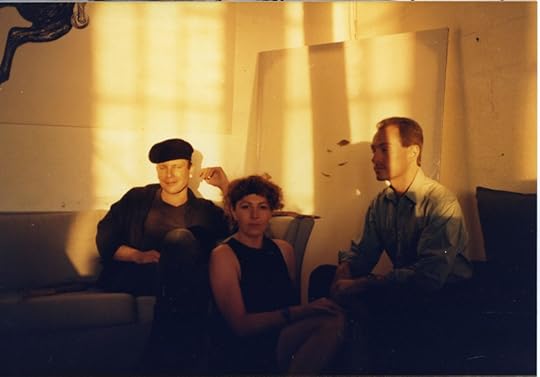
Sojourn in Los Feliz
This history takes a detour during the first few months of 1985, because I had temporarily moved to Los Angeles, joining Katie in her little bungalow in the quiet, sunny Los Feliz district, on a broad residential street lined with towering palm trees. There, I added extensively to my SoCal circle of friends through our frequent socializing and Katie’s generous introductions.
The previous summer had seen the beginning of a revolution in music production: a new company, Fostex, had launched a line of affordable multi-track recorders using convenient pre-existing tape formats. Suddenly, technology that had previously needed a professional studio and a five-figure budget could be acquired by virtually anyone and set up in your bedroom. After reuniting with ex-TI fiddler Mark T, I’d bought the Fostex 4-track cassette recorder/mixer, a briefcase-sized unit that enabled seemingly endless musical experimentation and the production of professional-sounding demos for promotion and booking gigs.
In Los Feliz, Katie and I put the Fostex to work, inventing a minimalist sound partly inspired by Young Marble Giants, writing and recording instrumentals as well as songs with lyrics, often juxtaposing two contrapuntal bass tracks. She was a smoker and horsewoman, and we starting working under the name Marlboro Men, later settling on Roundhouse. Laurie from the SF loft helped by providing historical hobo symbols for our graphics.
Since I had quit my Bay Area job, Katie also tried to help me find work down there. After dropping out of CalArts just short of her BFA in photographic art, she had developed a career in special effects. The 1980s were the last gasp of pre-digital effects, and she had spent the better part of a year rotoscoping – laboriously masking film images by hand with a pen, frame by frame – to create the blue eyes of the Fremen in David Lynch’s science fiction epic Dune. She got me a gig rotoscoping on an expensive commercial for Australian TV, in which a couple dozen of us worked in a big room on 12-hour shifts in 24-hour rotation, alongside other local artists like Nina Salerno and Joe Bishop. Joe was the life of the party with his caustic wit and constant wisecracking.
But this job suddenly ended when the Australian client refused to pay the Hollywood effects house. There were a few tense weeks as we waited to find out whether we would get any compensation for our work, but while we were waiting, Katie learned of a hot new production company that had opened in San Francisco and was already hiring some of her LA friends. And my old boss in the Bay Area wanted me back. So we both moved north to the Terra Incognita loft, where Katie immediately starting working at Colossal Pictures.
Terra Incognita Reborn
Shortly after our move to SF, we heard that our colleague and former co-worker Joe Bishop had died suddenly, of AIDs. He was the first widely known victim in the arts community, and it sent shock waves across the country.
Laurie’s new boyfriend, Sebastian, was a thoughtful and warm-hearted artist from an old aristocratic family in Portugal. Katie and I played him our Roundhouse tape, and it reminded him of England’s Penguin Cafe Orchestra, an experimental, ethnic-influenced chamber ensemble that would later become better-known when one of their instrumental pieces was used in an IBM commercial. Like the early Terra Incognita, they worked in odd time signatures and used ambient sound samples. Sebastian gave us a tape of their albums, we became huge fans, and they inspired me to keep pursuing a string-band sound.
Mark the fiddler was ready to pick up where we’d left off in 1984, so we re-formed Terra Incognita with me on electric guitar, Mark on electric violin, and Katie on electric bass. Mark had been experimenting with his fiddle for years, reinforcing the body, running it through amplifier distortion, adding a pick to the bow and teaching himself to play it percussively. In the new, totally unique sound we were developing, the picked fiddle became our percussion, with occasional traditional bowing to tie phrases together with melodic lines.
We all had day jobs, and on top of that, we were rehearsing five nights a week. All three of us were writing songs and trading off lead vocals while learning to simultaneously play complex polyrhythms on our instruments – far beyond what the Penguin Cafe or any other known artists were attempting. And most preposterously, none of us were even trained musicians.
Since I was working again at my old job, I could now afford the Fostex 1/4-inch 8-track recorder and mixer, and using it, we crafted a demo and started booking gigs. I sucked at marketing, so Katie stepped in and became our relentless promoter. In fact, from this distance in time I can see that Katie’s drive, her fearlessness and impatience, not to mention her persuasive charm, were responsible for whatever success we had. I have total faith in my talent and the quality of my work, but I can’t sell myself worth a damn.
Fittingly, the debut of the new TI was at Club Foot, the same place where the original TI had debuted four years earlier, and we were booked with the Invertebrates, an eccentric psychedelic-funk-performance-art ensemble that, oddly enough, more closely resembled the original Terra Incognita of 1981-1982. The Inverts became our friends and companions on many more gigs over the years.
Black Russians
Katie’s old friend Andy Chambers, an experimental filmmaker from Los Angeles who had grown up in an old California farming family and cultivated a rugged, taciturn Clint Eastwood persona, had acquired a wild and beautiful property in the Sierras, an abandoned and overgrown mountainside orchard below a legendary silver mine, and the two of us found time between jobs, rehearsals, and gigs to spend weekends camping up there in the woods and swimming in the boulder-strewn Merced River.
My old co-conspirator, Jon from the original TI, was living in New York, but we continued to collaborate long-distance, trying to build an arts community that would transcend the ironic bohemian cliches and celebrate mundane crafts like cooking. Our latest idea was a newsletter called TIPS, which would evolve into the next year’s Pow-Wow.
Laurie had a new boyfriend, Troy, a friendly, energetic young hustler from South Central Los Angeles. And John had teamed up with Terri, a quiet classics scholar with a young son. But all of our relationships were conflicted and unstable; Katie’s family had a history of violence and she’d inherited her father’s temper. Her meltdowns had scared me early in our relationship, but we’d already dived into so many intensely shared domains, from music to the desert to our home and friendships, it seemed there was no getting off this rollercoaster.
Shortly after Katie moved into the loft, Tiare had shown up outside, ringing our doorbell. As usual, I went to the front windows to see who it was, but Katie beat me there and started yelling at Tiare to get lost and never show her face again. And it was more than a decade after that before we reconnected.
In the aftermath of punk, post-punk, and new wave, the music scene had splintered into diffuse, divergent efforts. These were the years that saw the development of genres as diverse as electronic dance music, alt-rock, alt-country, and grunge, the emergence of stadium acts like REM and U2 as well as the persistence of urban icons Prince and The Smiths, all of which we danced to in the loft, with John keeping up his weekly rendezvous with trance at our neighborhood club, DNA.
Katie’s arrival had balanced out the loft population – two men and two women – and I can see in retrospect that that made it easier for us to do things as a group. From then on, for the first time, we loftmates began hanging out together, dancing together, heading out together for dinner and shows and parties and adventures.
In the fall, San Francisco’s cable car system was due to be shut down for a long period of maintenance, so we loftmates decided to hold a late-night wake, dressing in black and riding each line in succession from beginning to end, where we would toast with Black Russians in the nearest bar. I’ll never forget midnight, when we started the steep downhill segment of the California Street line, and John and I climbed to the roof of the car where we tottered, our jackets streaming in the wind, with the lights of the city and the Bay laid out below us.
Also that fall, late one night during a heavy rain, I was passing through the kitchen when I heard water dripping into the tub from the bathroom ceiling. Laurie was in her room, and I asked her if I could take the ladder up to the roof. There, I found almost the entire roof covered with a lake. I’d never really paid attention, but our flat roof drained into a pipe that ran down behind the tub, and this had clogged with debris collected from the entire 25’x100′ roof area. I waded over to the mouth of the pipe, and the water there was over six inches deep. Our roof was literally sagging under the weight of tons of trapped rainwater!
I managed to dig out most of the debris by hand, and the pooled water roared down the drainpipe – one of many close calls in our precarious, illegal existence.
Frosted Desert
Despite frequent reminders of our bohemian milieu, the four of us, with our reliable, relatively high-paying day jobs, were edging toward more bourgeois trappings. We decided to pool our resources for a TV, and I picked up a sleek, futuristic all-black video monitor at the Whole Earth Access store in Berkeley, a 1970s-era hippie emporium that had started catering to the emerging yuppie class. Laurie had established herself as our pop culture guru, and she and her best friend Madeline got us all addicted to a weekly ritual viewing of Knots Landing, the Dallas spinoff series that launched the career of Alec Baldwin, who played a creepy but seductive evangelical preacher.
I had also set up an annual order of a quarter-cord of firewood for our wood stove from a yard in Richmond, across the Bay. It would be dumped on the sidewalk and all four of us would plan to be at home, so we could hand it up the stairs from person to person in a human chain, stacking it carefully in a little corral I’d built against the wall of the front room.
Katie and I were the only loftmates with cars – Laurie and John were consummate urbanites – but we talked Laurie into accompanying us on a December road trip to our Mojave Desert cave. We arrived, shocked, to find the desert under six inches of snow, but we’d brought plenty of artificial stimulants, and quickly set to work making the cave cozy and warm.
In the morning the desert landscape appeared more enchanted than ever. We dosed on magic mushrooms and hiked a couple of miles through a frosted boulder field to an old ranch house, where we were surprised to meet Chris, the son of San Francisco’s assassinated mayor, a solitary biology student who eagerly accepted our offer of shrooms, joined us for the rest of our trip, and reconnected with us later in the loft at Christmas.
By the end of the year, after seven months of gigging, the new Terra Incognita band had established itself in the local music community, headlining the New Year’s Eve show at the V.I.S. club, which would later become the more famous Kennel Club and Independent, hosting major international acts. Our first friends in the scene were Josiah from the Invertebrates and his best buddy Carson, an artist who happened to be Mark the fiddler’s roommate. Carson and his fiancee, Kay, were always dancing in front of the stage at our shows, often accompanied by Rippy, a member of the experimental group Bardo, who was obsessed with my guitar style. We also did several gigs together with Blue Movie, a new wave group that jammed with us at the loft.
Like most of our colleagues, our dream was to become rich and famous, but strictly on our own terms as artists. We wanted to sell records and tour the world to the ringing acclaim of our peers.
Apocalypse New
In the new year of 1986, Katie’s ambition brought us into contact with more successful colleagues. Fellow musicians referred us to Tom Mallon, the hot new local producer, who recorded our first professional demo. Frank, bass player in the internationally-known local post-punk band, Romeo Void, moved into the apartment next door above Olen’s record shop. We met, gigged and jammed with, and became good friends with, Romeo Void sax player Benjamin and his new musical partner, Norman. All of them had credentials beyond ours, but to Katie’s endless frustration, I remained, to some degree, stubbornly aloof – I was single-mindedly obsessed with King Sunny Ade’s juju music, and it was hard for me to accept or recognize the value of other styles or genres.
We submitted our latest demo to Calendar Magazine, the local entertainment guide, and got high praise from their reviewer, Cary, who compared us to the 1960s English folk fusion group, Pentangle. Later in the year he would give us another rave review and become one of our pals and colleagues as he went on to pursue his own writing and performing career.
In April, the Chernobyl nuclear plant in the Ukraine exploded, melted down, and spewed toxic material across the northern hemisphere. We were back to the old apocalyptic days of the late 1970s, when I had marched against Three Mile Island. This new disaster unfolded over the remainder of the year and demonstrated to the whole world the insanity of nuclear technology as well as the foolishness of reliance on government oversight.
Simultaneously, information began emerging in the media about the Reagan administration’s secret, illegal sales of weapons to Iran to fund right wing death squads in Nicaragua. The actor president and his highest ministers were finally revealed to the world as the criminals I and my peers had expected them to be. A deadly epidemic was decimating our friends and fellow artists around the world, while the government played the same old games with money and power and peoples’ lives, and the complacent yuppie class basked in the glow of its seductive computer technology.
Terra Incognita had become the “house band” at Katie’s workplace, trendy special effects house Colossal Pictures, and the Colossal people had become fixtures at our gigs. We became close friends with Stuart, a charming, theatrical art director and collage artist who liked to dramatize everything and everyone he favored with his attention.
We solidified our friendship with Carson and Kay, now married, and with new fans Paul and Denise, a bohemian couple who also danced in front of the stage at our shows. We began a series of collaborations with Serge El Beze, an Algerian-born theater artist, musician and DJ who would become world-famous in the 1990s as Cheb i Sabbah, and with Pamela Z, an ambitious electronic musician who produced large-scale collaborative performance events that always included TI.
We also became friends with a more laid-back psychedelic group from Southern California, the Whitefronts, jammed with them at the loft, and added Scott, one of their members, to our informal family.
John began a tempestuous affair at the loft with Christy, a sultry, mercurial theater artist from his On/Ramp group, and their fireworks entertained us throughout the year.
Pow-Wow ’86
Then one night, I got a call from my Dad’s place up in Sacramento. My stepmother, a bipolar drug addict, had literally blown her brains out with my Dad’s 45 magnum pistol, and Katie and I had to drive up in the middle of the night, comfort my hysterical Dad, and clean up.
Laurie continued to refine her lightbox art, improving the hardware and electrical components as well as the carpentry and graphics. And she had met Marc, a brooding Berkeley grad student from New York who always wore a baggy tweed sport coat and was obsessed with postmodern literary theory. He was also fond of the bottle, and quickly sparked Katie’s ire by pilfering her loose change to buy liquor.
After joining us at our desert cave, Laurie had made a lightbox for Katie and me, capturing one of my occasional sagelike observations: “Documentation is the source of future satisfaction.” The irony of this only emerged later, when I discovered how spotty our documentation was during those years before the advent of digital and mobile media. I didn’t even have a camera of my own until Katie gave me a little autofocus point-and-shoot SLR for my birthday in 1987, and even then I seldom remembered to use it, because I’d never developed the habit of documenting life that way. From today’s perspective, it’s puzzling and frustrating that we hardly have any photos, let alone videos, of Terra Incognita shows from that period, or the numerous happy times we loftmates had together.
Over the summer, in addition to the band’s busy schedule, I began seriously collaborating with Jon on an event to be called the Pow-Wow, scheduled at the loft in the fall, gathering together our diverse friends from the arts and sciences in a community-building exercise in which we would share whatever we were passionate about, anchored around talks by Jon and my old friend Jack, a messianic engineer, educator, and population activist from Stanford. The idea struck a chord with everyone in my community, including those like Michael W and Nancy E from the ex-CalArts crowd in Los Angeles, who would participate remotely by phone and mail.
The first Pow-Wow went gloriously, far exceeding any of our expectations, in a Friday through Monday marathon that flowed deliriously from collaborative cooking and dining to passionately confessional group introductions and equally passionate topical discussions, late-night musical jamming, morning computer art workshops, and more of the same. Two of our artist friends had recently acquired the new Apple Macintosh computer, and this Pow-Wow was a local preview of its potential for the arts, which would take another decade to mature.
Rank Stranger
Despite how powerful the new home recording technology was for writing music and mixing demos, it still wasn’t good enough to make commercial grade recordings. By the start of 1987, I had saved up another little nest egg from my day job, and was determined to record a Terra Incognita album that we could then shop around to independent record companies.
The conventional approach would’ve been to shop our demo to the record companies and get them to fund the recording, but I didn’t have the patience – or maybe the confidence – to wait for that to happen. So we went on studio visits all over the city, finally settling on a relatively obscure operation way out in the Sunset District run by a congenial guy named Dave Wellhausen. I think we chose him partly because he wasn’t intimidating like the more famous, and more expensive, studios. And over a six-month period, we recorded, and re-recorded, and fine-tuned, and spent all my money, running those tracks into the ground trying to make them “perfect” – whatever that meant at the time.
In April, Katie and I took a big block of time off to pursue another of our new passions: Native American rock art. I’d first encountered it in books back in 1982, as an inspiration for my visual art, then Katie and I had begun to spot petroglyphs in the desert and collect more books that fed the graphics for our TI shows and demos. Katie had even started designing t-shirts with petroglyph imagery.
Our rock art trip through Nevada, Utah, and the Mojave was truly epic. We discovered the unearthly Barrier Canyon style together, and the pristine cliff dwellings of Grand Gulch, and we each took a quarter hit of acid each time we started a hike, adding a glow to the entire, exotic landscape and heightening our awareness of the Ancient Ones and their culture. Back home, our band graphics came to be almost completely dominated by Native American imagery.
Our musical best friends Norman and Benjamin had moved to the Big Apple to seek the next level of their duo career, but we found new local colleagues in girl garage band The Furies and emerging alt-rock stars American Music Club, both of which we did multiple gigs and birthday parties with. And we landed prestigious positions as opener for national touring acts like Brave Combo, Camper Van Beethoven, and a then-obscure Oklahoma band called Flaming Lips.
I’d become disillusioned with our seemingly endless recording sessions at Dave Wellhausen Studio. We enjoyed hanging out with Dave, and consuming delicious Middle-Eastern takeout from a nearby Persian deli, and Dave definitely enjoyed the thousands of dollars I was paying him for his time, but I was losing my passion for the music.
Katie, however, still had bigger plans for us, and she got one of our new recordings, our cover of the Stanley Brothers classic “Rank Stranger,” onto a compilation album being released by the local label Ralph Records, home of the notorious avant-garde ensemble, the Residents. When the record came out, our track received high praise in both the Los Angeles Times and New York’s Village Voice. It was our big breakthrough – now what would we do with it?
Despite the upscale business downstairs, our loft neighborhood remained very marginal and potentially dangerous. Harvey’s store had moved closer, from Clara to Shipley, and he’d opened his new back lot to the bike messengers that depended on him for check cashing. One Friday afternoon they went crazy, starting a drunken, coke-and-meth-fueled riot like something out of The Road Warrior, leading to a police crackdown.
Then one night in early summer, I was about to fall asleep when I heard heavy footsteps thudding on our roof above. What the HELL?
There was just me and Katie in our bed, and Marc and Laurie in hers – John was out for the night – so I scrambled out and went up John’s ladder to his trapdoor. Lifting the plexiglass hatch here at the back of the building, I peered out, finally spotting a big silhouette leaning over the facade in front, its back to me. “What the hell are you doing!” I shouted, without even thinking about consequences.
The figure turned slowly around and began silently advancing toward me across the length of the roof. It was a young man dressed in camouflage battle fatigues and carrying what appeared to be an assault rifle.
When he got close enough that I could see his face, he grinned and said “I was just playing. I didn’t know anyone lived here!” Then he ran to the side of the roof overhanging the tenement southeast of us, jumped over, and sprinted across to the next building, another artist warehouse owned by our landlord.
When he reached the roof on the corner, I could see the tenants there poking their heads out of their own trapdoor to start yelling at him. The last I saw of him, he was running away from them, trying to get to the next roof. We called the cops, but by the time they arrived, he was long gone.
Bereft
Laurie’s boyfriend Marc had been spending a lot of time at the loft. When I was alone with him, one on one, he could be charming, respectful, and open-hearted, but in a social setting things were different. Like most in academia, Marc put a high price on intelligence, and the academic measure of intelligence tends to be demonstrated and proven rhetorically, by competing with and dominating others in conversation. He had run-ins with everyone who frequented the loft, and he occasionally targeted me as if we were rivals, wielding the technical jargon of his field to put me at a disadvantage.
It’s hard enough to sustain friendships between artists – harder still for us to work together – and hardest of all to live together, especially under the stress of an illegal, do-it-yourself habitation in a dangerous neighborhood. Katie and I had imposed our band rehearsals on Laurie and John for years. I had accepted my troubled brother’s occasional visits, when he would harass the women with his homemade pornography and graphic stories of swingers’ clubs. Katie would be the first to admit that her German ancestry made her domineering and intolerant, whereas I was mostly oblivious of my own obsessive-compulsive and passive-aggressive bad habits.
But Laurie was in love with Marc, and as the summer passed, it transpired that they would move to Minneapolis together and get married. She’d been our roommate for five years, and it was a traumatic loss, not least because we feared he would drag her down in a self-destructive alcoholic spiral.
For three years, since Katie had joined us in the loft, we’d been a cohesive household. In that atmosphere, the efforts of Jon and me to build a larger community had taken root in the first Pow-Wow, and would continue to bear fruit in the years ahead. But this was the golden age of the loft, the only time when our household really hung together and thrived. The addition of Katie had made it happen, and the subtraction of Laurie would end it.
On the day their moving truck rattled off down Fifth Street toward the freeway ramp and the long journey east, we were bereft. Katie and I had some blotter acid and we split it with John, spending the rest of the day in a stunned wake, ending up high as kites in Golden Gate Park in late afternoon, stumbling around the drained, bleak concrete fly-casting pools, alone in the fog with our loss.
December 25, 2016
The Terra Incognita Loft: Part 2 1982-1984
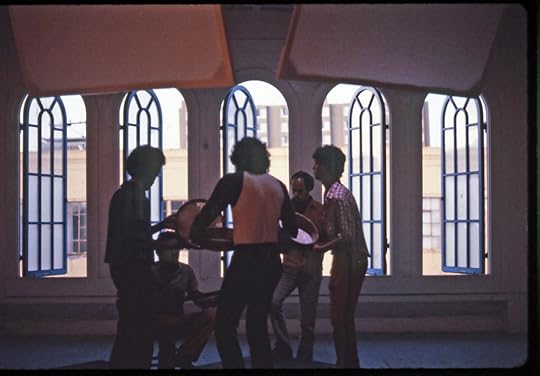
Rising From the Rubble
The city was going through major changes. While Jon and I were struggling to build community at Terra Incognita, all the other underground art spaces in San Francisco were closing, and the vibrant art scene that had thrived in the wake of punk music was collapsing as everyone faced the harsh realities of the Reagan years.
Five people sharing the loft had been an experiment. After Mark and Scott’s exit, and Mark’s late-night hammer attack, I decided that three was a more reasonable number. Although we stayed best friends, Tiare was spooked by Mark’s attack, and she moved out soon after. Then I tore down the two walls between Scott’s, Mark’s, and Tiare’s old rooms, and built a new wall dividing the remaining space into two larger, more usable private rooms.
I also wanted more stable, reliable roommates, and in one of the miracles of my life, I found them almost immediately in Laurie and John, the best roommates I’ve ever had. Laurie was a postmodern artist who worked full-time as a graphic designer, and John was a polymath and theatrical artist-of-all-trades who worked full-time as a computer programmer. He built a sleeping loft in his room to match Laurie’s and mine, Laurie installed some of her art work, and together, we gradually transformed the loft into a world-class home, studio, and venue.
Music, Prophecy, and Lust
With the band dissolved, Jon and I threw more energy into planning our multi-media events, and I devoted more private time to visual art. At a party in April, I met Victoria, a vivacious Italian-American woman a few years younger than me, with a heavy, glossy mane of jet-black hair. She introduced herself as an aspiring writer, photographer, and actress who also happened to be a vice president at one of California’s largest banks. We hit it off and exchanged phone numbers, and when Jon and I scheduled the first event of our new Music & Prophecy series for May 1, I invited Victoria.
Despite the chemistry, and her attraction to the novelty of my bohemian lifestyle, there was a deep cultural gap between us. I’ll never forget my chagrin at first visiting her apartment on Union Street, ground zero for yuppies. Her furniture and decor were totally bourgeois, heavy on floral prints, throw pillows and lace. But that all blurred into the background as she started tearing off my clothes, and we ended up in a two-year relationship.
Another big change in my life had to do with the desert. Immediately after my first date with Victoria, my CalArts friend Mark had invited me on a camping trip in a remote, exotically beautiful corner of the Mojave, where we slept in a cave under a granite boulder. That clinched my obsession with the desert that would spread to affect everyone else in the loft community and continue to grow for decades.
Inspired by our Music & Prophecy kickoff, which had included rare industrial films by Craig Baldwin, the city’s dean of experimental film, I temporarily quit my day job, and Jon and I spent the month of June planning two ambitious events for July. I built a two-piece modular stage that could be assembled in different shapes, and projection screens that could be hung at angles from the ceiling. We met with Yasir and his group to review samples of Arabic calligraphy that could be used for our posters and projections, and to plan a menu of Moroccan food.
Earlier in the year, I’d been approached at my favorite coffee house by an imperious, strikingly beautiful local actress, Patricia Butler, who had recruited me to play the lovers of Edith Piaf in a two-person performance piece she’d written. There would only be one staging, to be filmed for her acting portfolio, and my part would be silent, with the role changes signified only by changes of costume. It was quite an experience for me to represent Marcel Cerdan, a famous French boxer, not to mention the four other guys!
In return, we asked Patricia to do a dramatic reading at Music & Prophecy of a story of her choice by Isabelle Eberhardt, the tragic genius and desert lover who posed as a man in North Africa and drowned in a flash flood at the age of 27 with her Arab husband, deep in the Sahara. Patricia picked the most melodramatic story, of a young woman’s suicide, and after the final crushing line, I struck the lights and she made the perfect stage exit, down the stairs and out our lives forever.
Reflections on Black Plastic
I was still driving my old 1965 VW Beetle, which I had been doing all the maintenance and repairs on since moving to California in 1976. Now, the front end needed rebuilding, and in the midst of everything else that was going on, I started working on that, in the dirt lot across the street where I kept it parked. One day while I was sprawled underneath with the front end up on blocks, two guys hailed me as they crossed Fifth from the corner at Shipley. I was a captive audience, and they were offering to help, so there wasn’t much I could do. It was clear that they were ex-cons from Dancey’s crew in the tenement behind our loft, and as I got to know them over the next few weeks, I discovered they’d both been released from San Quentin after doing time on felony charges. One was tall and massive, built like a linebacker, while the other looked more like a basketball player.
They started out on their best behavior, treating me with respect and restraint, but as soon as they found out we were hosting public events, they made themselves at home and began hitting on the girls at Terra Incognita. At one Music & Prophecy night, I was trying to be everywhere at once and solve everyone’s problems, when Laurie pulled me aside and said I would have to get rid of the ex-cons. So somehow, without even thinking of the danger, I corralled those two drunken giants and shepherded them down the stairs and out the door, marshaling deep reserves of tact I never knew I had. Jon was watching and came over to give me a supportive hug when I returned to the top of the stairs.
The next, and as it turned out, the final, Music & Prophecy featured my CalArts friend Larry, a wry, jaded photo artist who had a little of the old Clark Gable vibe. Larry had started experimenting with black and white portraits taken with flash against a background of black plastic, falling somewhere in the Sally Mann – Helmut Newton spectrum. Collaborating with Larry at a distance, Jon and I put together a program in which the front room would be completely lined with black plastic, Larry would set up a portrait station at one end, jugglers would entertain and titillate by passing flaming firebrands the length of the plastic-lined room, and Scott’s new rock band would finish off the night.
Celebrity Photo Nite was a huge success until the band started playing at midnight. One of our neighbors immediately called the cops and we were shut down after the second song, for disturbing the peace. And then at 1am, long after the band had loaded out and we’d started to clean up, a big crowd of the band’s fans showed up at the front door, demanding a show. So much for Music & Prophecy.
Embracing Decadence
Downstairs from us, after a year with no rent payments, landlord Chuck finally closed a deal with the anarchists: since eviction had become virtually impossible in San Francisco, he simply paid them thousands of dollars to move out. Next, a couple with a young child moved in and spent weeks rebuilding, turning the mezzanine level, immediately below us, into a more upscale open-plan space like ours. But then the husband began beating on the wife, and the kid started screaming….
Another young couple moved into the tenement apartment on our south side. He was friendly and had a steady job, but she turned out to be dangerously psychotic, so that he had to keep her confined indoors. I’ll never forget the afternoon when she escaped, and ran naked into the middle of Fifth Street, where she collapsed, thrashing and howling plaintively, in the midst of heavy traffic.
My new roommates, Laurie and John, were both into the minimal look. John dressed all in black and had laboriously lined the floor of his room with hundreds of black plastic rectangles he’d found abandoned somewhere in the neighborhood. The two of them prevailed upon me to repaint the blue floor, and we settled on the radical solution of a glossy white floor. This implied high maintenance, leading us to buy a vacuum cleaner and hire a housekeeper, a friend of Laurie’s who came in one day a week. Her partner, Ellen, followed, becoming another new member of our loft family, which from now on would include John and Laurie’s partners as well as friends and relatives, both local and visiting from out of town.
We also pooled our funds for a washer and dryer that I installed in the bathroom, ending the long trips to laundromats. I also picked up a huge door at Cleveland Wrecking that I turned into a kitchen table big enough to seat a dozen people. It was such a relief to finally have roommates that could contribute, instead of just taking advantage of my steady job and reliable income!
With his long theater background, including guerilla performances across Europe, John became an integral part of a local group called On/Ramp. Laurie, whose previous installation work had been text-based and cerebral, started experimenting with more ambitious and evocative “light boxes,” shallow wooden chambers with an interior photo backdrop and a hinged front cover framing a sheet of acetate printed with a foreground photo which was backlit by a lamp hidden inside the box.
Tiare and I were still best buds – Victoria was generously accepting of our close friendship – but she had a new boyfriend – a stylish, reserved professional trumpet player who was transitioning from Art Lande’s jazz group to Van Morrison’s touring band. She’d invite me over to his elegant bungalow on Bernal Hill while he was touring, and I’d noodle dreamily on his Steinway piano, an instrument I can only play while buzzed and stoned.
Alongside all of this social and creative activity in the San Francisco loft, I was living a parallel life in Southern California, driving down to CalArts every few months to play in Mark N’s new group, the tribal/electronic Our Camp, along with a new CalArts friend, Claire. My SoCal connection made me unique in San Francisco, a sort of cultural ambassador between cities that had always been antagonistic.
Partly because my work with Jon in San Francisco was becoming more and more structured and organized, I gravitated toward free improvisation with Mark at CalArts, and we started recording drunken jams and raps under the name of Didactyl Brothers, Daryl (Mark) and Dartaigne (Max), a multi-media art duo riffing on the didacticism of conceptual art, the CalArts-based movement which was then struggling against the rise of Neo-Expressionism. The Didactyl Brothers were irreverent, confrontational, and infantile – a total contrast to the serious, reserved image I presented elsewhere. During my trips, we created and exhibited notorious, disruptive guerilla art shows in the CalArts Main Gallery.
In the fall of 1982, Jon and Tiare joined me on a trip to CalArts, where Jon and I jammed and recorded as Terra Incognita with Mark and his CalArts buddies, and Tiare and Claire became friends and “Didactyl Sisters.” And later that year, Tiare and I participated at the San Francisco Art Institute in a groundbreaking live video linkup with Claire and others at CalArts, and produced a Didactyl Brother and Sister guerilla art intervention at the Art Institute’s main gallery.
Another major CalArts-based trend in my life revolved around Las Vegas and gambling. This was probably an ironic reaction to the conservative Reagan years, as well as an extension of bohemian, low-rent desert gambling trips that Mark and I had started taking in the late 1970s. Now, we teamed up with Larry the photographer, who nudged us in a faux-rat-pack direction, and our Las Vegas trips took on a dimension of epic decadence, with all-night binges at the craps table, followed by hungover tennis matches in the unforgiving desert sun. We’d also started seeking bliss in pharmaceuticals, and I exported as much of this new culture as I could back to San Francisco.
Victoria was less than impressed when I dosed and nodded out in the middle of her yuppie dinner parties, but on the plus side, we took up tennis together, and I even showed up, scandalously, at one of roommate Laurie’s art shows, wearing my tennis outfit.
As I embraced this temporary camouflage, my relationship with bourgeois Victoria began to look like a sort of ironic lark, a self-conscious flirtation with squareness. I truly loved her, but this could hardly be sustainable.
With all the underground art spaces shut down, young people in the cities gravitated toward a new form of nightlife. Punk and post-punk had evolved into new wave dance music, the urban dance scene was blossoming all over the world, and our neighborhood, South of Market, was its center in San Francisco. We all became regulars at DNA, a cavernous corner club with a central bar, a few blocks southwest of us. This was the time of Michael Jackson’s Thriller and the Eurythmics’ Sweet Dreams. Victoria and I made great dance partners, and my wardrobe graduated from the Salvation Army to the retro boutiques.
But this second year of the Reagan ordeal was also the dawn of AIDs. We started hearing of it, but had no idea what it meant or how bad it would get.
Dance, Drama, and Irony
I moved into the new year of 1983 without the structure of Music & Prophecy or the Terra Incognita band to anchor me and deploy my creative energies. Laurie and John were comfortably settled in the loft, their jobs and relationships, and John was moonlighting as both actor and director in the On/Ramp group. I continued to move my visual art forward, but Victoria was making it clear that she was on a relentless track toward marriage and children, and it took more and more of my energy to maintain a relationship with someone whose goals were completely different from mine.
This came to a head one day in early summer, when she invited me to lunch at The Ramp, a bohemian burger and beer garden on the waterfront in the shipyard district south of downtown. Her plan was to give me the marriage ultimatum, but I decided to treat it ironically, suggesting that we have a Vegas wedding and enjoy it while it lasted, without any expectations for the future.
To her credit, she took this preposterous suggestion gracefully, merely shaking her head in resignation. That night, we drove to a trash-lined alley between abandoned railroad tracks and an abandoned factory, smoked a joint, and had a wild bohemian fling in the back of her station wagon. The artist had won, for the time being.
Meanwhile, as AIDs was wreaking havoc in the gay community, the media reported that heterosexuals were also at risk through unsafe sex. Fear spread through the cities, where partnerships were more fluid, accelerating the trend toward conservatism in culture and society. The sexual freedom of the 1970s was over, and monogamy became the choice of the prudent.
So, postponing a decision about our relationship, Victoria sublimated her dream of marriage in creative work, joining John’s On/Ramp group as an actress. I should’ve welcomed this, but since I now lacked a creative collaboration of my own, I was childishly jealous of her and the theater. I even resented On/Ramp’s rehearsals in the front room of the loft, which I’d used dozens of times for my own band.
Downstairs, the abusive family moved out, and an upscale construction company, Ludington Construction, moved in, redecorating yet again. This worked out well for us, because they worked regular daytime hours, and we finally had the building to ourselves at night.
Outside the loft, the neighborhood remained sketchy. A Vietnamese family moved into the eastside tenement, and one afternoon I happened to be in my room when I noticed the neighbor kids setting fire to a mattress on the roof outside my window.
Over the previous winter, a new French-produced album had come out featuring Nigerian pop star King Sunny Ade, and Victoria and I had fallen in love with juju dance music, dragging Jon to King Sunny’s first Bay Area show, in Berkeley. I became obsessed with juju, adapting my old bluegrass flatpicking guitar style to juju-inspired polyrhythms, and dreaming of a new African-inspired style of original music.
Some Nigerian dancers at King Sunny’s shows were wearing robes patterned with the Mercedes-Benz logo, a symbol of prosperity. I was tired of perpetually working on my old Beetle and decided to look for a used Mercedes, hoping it would win me points with the African expatriates in the Bay Area. And after I found one, a 1962 diesel sedan with white tuck-and-roll seats, Victoria and I decided to revitalize our relationship with a road trip to the East Coast, stopping off to see Jon, who had moved back home to Iowa, and my family, in Indiana.
In New York City, we were treated to a night in the spectacular metallic-gold-painted Little Italy flat of art star Sherrie Levine, a friend from CalArts. And, dance-crazy as we were, we spent an entire night dancing our way across New York’s most famous nightclubs, finally lurching blissfully into a Manhattan dawn.
Although he’d moved away, Jon and I were still close, holding long phone sessions late at night, collaborating on ideas for music, art, and events. I was excited about the direction my visual art was taking, and he badgered me to give up music completely and focus on art, where he thought my talent was stronger.
Go South, Young Artist
Victoria’s older sister Patti was an art director in the movie industry, the girlfriend of a famous video artist, and a fixture in the Los Angeles art scene. We’d visited her Hollywood apartment for an art party the previous winter, dropping our new King Sunny album on her stereo and dancing while conceptual art star Stephen Prina led the rest of the group to the bedroom to snort lines of coke. Patti introduced us to rising gallerist Richard Kuhlenschmidt, who was helping to put the LA scene on the international art map. The four of us hung out, and he took an interest in my work.
At the same time, Mark and Larry were getting involved with another ambitious gallerist, James Turcotte, who had recently scored a beautiful space just off a gentrifying section of inner Wilshire Boulevard. He currently hosted a group show including an elegantly eerie plaster image of a tornado by sculptor Dana Duff; I showed him slides of my work in progress and he scheduled me for a two-person show with Dana in summer 1984. It was my first real opportunity in any of the arts, and intense preparations took over my life back home.
Meanwhile, my day job flew me to New England for a few days, and on the way back, I stopped in New York to spend a couple of nights at the Manhattan loft of Andy Moses, son of Los Angeles art star Ed Moses. Andy took me to a series of loft parties, including one at Robert Rauschenberg’s East Coast studio, and another on a rooftop where experimental films were projected on the opposite building. My head was in the clouds; I was finally getting somewhere.
The work I planned to show with Turcotte was based on the mixed-media drawings on raw canvas that I’d been creating for the past couple of years, enriched by my recent research into Native American rock art and prehistoric culture. A friend had given me an inspirational book on the radical Swedish artist Oyvind Fahlstrom, who assembled wall-hanging installations from miscellaneous collections of graphical elements, and in conversations with Turcotte, I began to envision a layered, conceptually sophisticated presentation in which my canvas drawings would be displayed along with other suggestive items that I would create or collect, the whole assemblage would be photographed and printed in large format, and prints would be available for purchase at a reasonable price, in addition to the original assemblage – a two-tiered marketing strategy.
In the early months of 1984, I was working hard and sinking lots of money into large-format photography, printing, and framing, and Turcotte assured me that we were on track. Everything was copacetic in the loft, and my relationship with Victoria seemed to be on autopilot. Then, at the end of April, with the show only two months away, I was starting to get anxious about finishing on time, and uncertain about the quality of the product, when I suddenly received a short letter from Turcotte saying he’d had to cancel the show due to overbooking.
Stunned, I immediately called the gallerist. He said that in addition to booking problems, he didn’t think my work was really ready to show, and, humiliated, I threw a tantrum, telling him none of my friends would ever set foot in his gallery again. I also talked to Dana; she was shocked and disappointed, but there was nothing either of us could do.
Victoria was with me as I read the letter; she comforted me, but she also announced – with all the compassion she could muster – that our relationship had to end, so she could be free to pursue her dream of marriage and family. She’d met a corporate lawyer who wanted to go out with her – clearly a better match – and he claimed to share her goals.
Turcotte’s cancellation aborted my gallery career in the visual arts. Whereas with most people it would be only a temporary setback, I realized I just wasn’t committed to the commercial gallery scene. I had an easy day job, and I was much more interested in experimenting and growing my art work organically, not in grooming it for a fiercely competitive market. I eventually came to agree that the planned assemblage and photo presentation were weak; my drawings were as strong as anything out there, but you can’t build a career on drawings – they’re considered secondary work, only marketable if you’re already established with “major” work like paintings.
Cowgirl in the Band
Things happened fast in those days. When I told Mark about the breakup with Victoria, he invited me to Los Angeles to play a gig with his new country band, Days of Glory, so I grabbed my banjo and jumped on Amtrak. I met them at the Frolic II, a new art scene bar in Hollywood. Katie, the standup-bass player, was there with her current boyfriend, a successful Neo-Expressionist painter, and John Baldessari, the international art star and CalArts teacher that she was escorting around town. Five inches taller than me, she was a party girl with a Mona Lisa smile and a svelte body, and later in the evening, when we found ourselves alone together out on the grubby Hollywood sidewalk, she literally swept me off my feet.
Mark and I left on a desert camping trip the day after the gig. It was the year of Halley’s Comet, and to celebrate, we made giant symbolic tempera paintings on the side of a house-sized boulder near our cave. But on my return to the city, Katie and I immediately became an item. She seemed to be exactly what I needed – a fearless tomboy from North Dakota, at home in the wilderness, but also an ambitious and well-connected artist, musician, and urban bohemian with an impeccable fashion sense. The only problem was that she lived in Los Angeles, but I was already used to commuting between SF and LA several times a year.
A couple weeks later she flew up to visit me, and I introduced her to the loft family, where she fit right in. She scrutinized my art, and contradicted Jon by insisting that I give up art for music, since, in her opinion, I had more talent for the latter.
But I wasn’t ready to give up on art completely – shortly after abandoning painting for drawing, I had started experimenting with pastels. I loved rubbing and blending colors with my fingers and hands, and the desert was inspiring me with new forms both natural and surrealistic.
Laurie’s friend Madeline, also an artist and fashion model, had moved into a warehouse space a few steps away, across Fifth on Clara Street, with her boyfriend Andrew, bass player for the notorious local post-punk act, Minimal Man. And I reconnected with Mark, the Terra Incognita fiddler who’d attacked Tiare’s room two years ago. Together, often playing and recording outdoors on the loft roof high above the city, we began developing a new electric string band sound, blending King Sunny’s Nigerian juju rhythms with the bluegrass styles both of us had learned in the 1970s.
Tiare’s boyfriend was still touring with Van Morrison, and Van had recruited them all, including Tiare, into Scientology, which drove a wedge between us. We were still in touch, but I was keeping my distance.
My old Volkswagen was on its last legs. Our musician neighbor, Andrew, recommended the Honda Civic Wagon, a quirky car design that had just come out, looked like a toaster, and would be perfect for hauling both musical instruments and camping gear. It was the first new car I’d ever bought on my own, and I special-ordered it in a desert tan color that perfectly matched our Mojave landscape.
On my trips to LA to see Katie, I jammed with Days of Glory, working out some of the tunes I would later use with the new Terra Incognita, and she and I got comfortable playing together. I also took her out to the Mojave, where we found a cave of our own, larger and nicer than Mark’s, and spent a week improving and furnishing it as a home away from home.
Meanwhile, Jon from TI had landed a writing gig in New York, and I made a special trip out to visit him. One afternoon as we walked up a street of sidewalk cafes in the East Village, I spotted my ex-girlfriend Kathy from San Francisco. That first year in the loft already felt like ancient history, and I had nothing left to say to her.
Katie and I were anxious to start writing and recording music together. She had a quiet, shady bungalow in desirable Los Feliz and high-paying hourly work doing special effects in the movie industry, so moving to SF wasn’t a great option for her. But I’d saved up a little nest egg, so at the end of 1984, I quit my day job again and packed up, leaving everything at the loft as it was, hoping to return and rejoin Laurie and John sometime soon. Reagan had been re-elected in a landslide, and it had recently been announced that AIDs was spreading through IV drug use in both the gay and straight communities. A full-blown epidemic loomed on the horizon, and many in our arts community were at risk. My move wasn’t exactly a leap into the unknown, but it was definitely the beginning of a new story.

